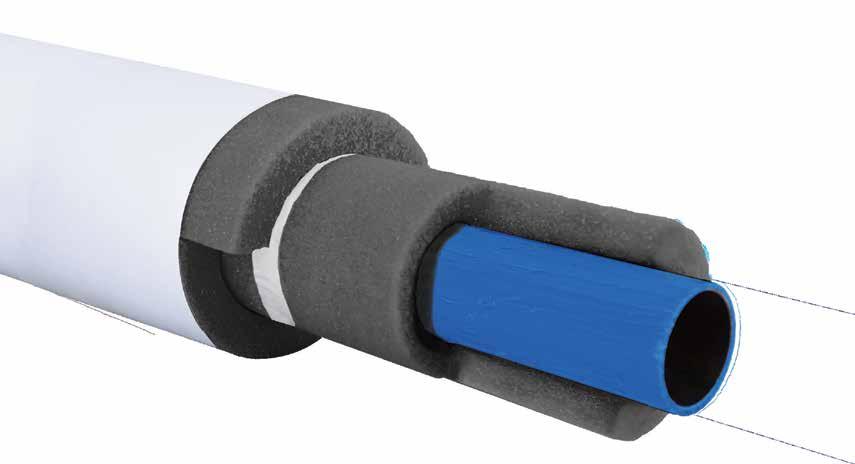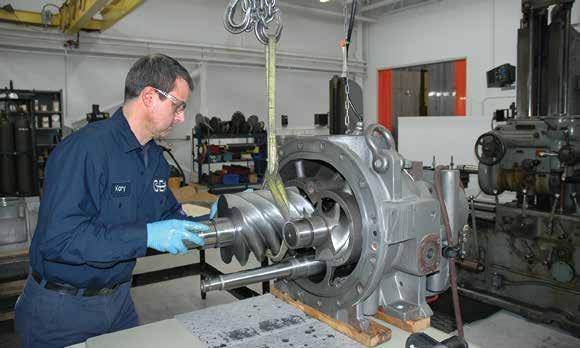HYDROCARBONS: IIAR EXPANDS HORIZONS WITH NEW STANDARD
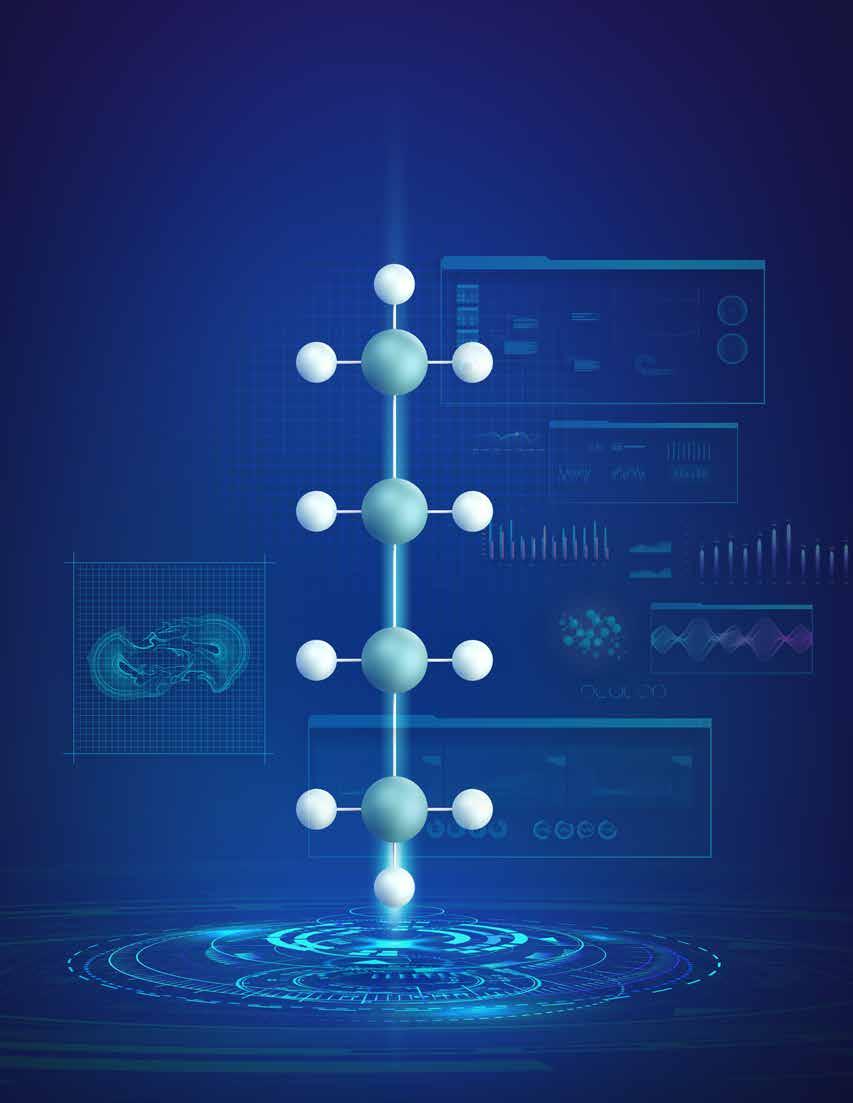
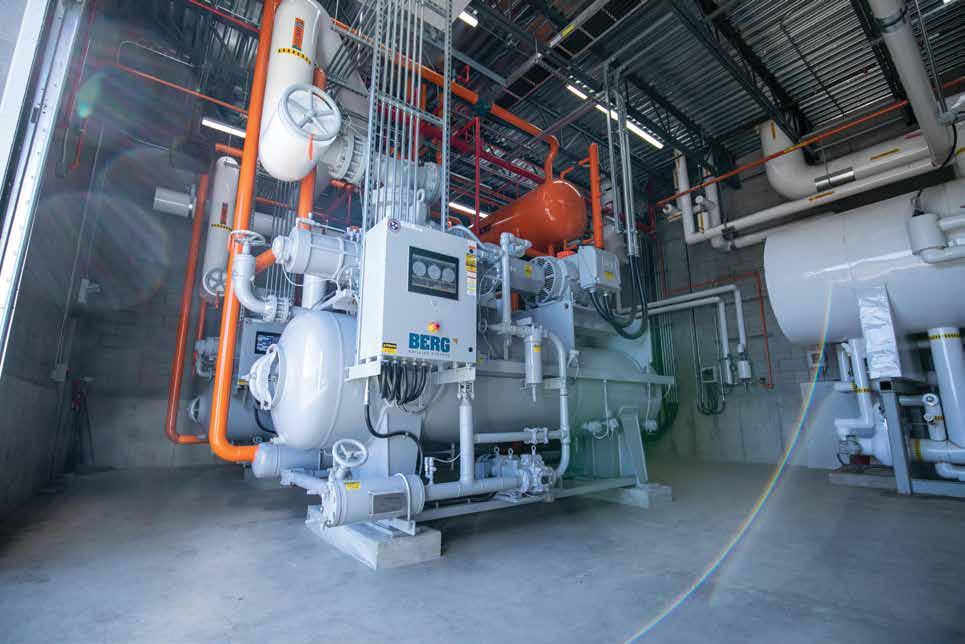



Evapco LMP Transcritical CO2 Systems are the NATURAL choice for many applications, including Cold Storages. These systems offer an efficient, environmentally friendly, and sustainable solution to your refrigeration needs.



Utilizing Evapco’s certifiable, high pressure CO2 evaporators and industrial eco-Air gas cooler, on your next transcritical CO2 project will ensure the highest system efficiencies and single source responsible from your trusted partner, Evapco Visit us at Evapcolmp.ca evapco.com


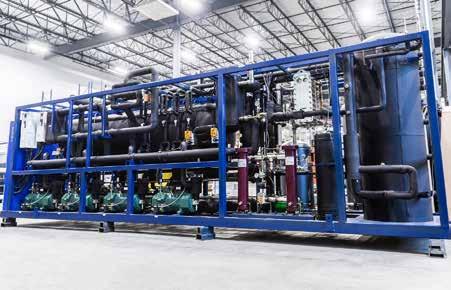



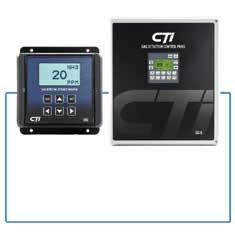



1001 North Fairfax Street, Suite 503 Alexandria, VA 22314 www.iiar.org Phone: 703-312-4200 Fax: 703-312-0065


This month I’m dedicating my column space to one of our organization’s most important ongoing activi ties, our membership. As an IIAR member, we all depend on you to take that essential first step to partici pate in the activism and advocacy of
change. From the free-with-membership resources, like IIAR’s online training, to the new digital platform housing IIAR’s standards, publications, and other educational material, people are taking advantage of the benefits of IIAR membership like never before.
At the beginning of this year, IIAR
members, and later, an executive com mittee task force who came together to discuss the issue and delve into ways membership could add value. Ulti mately, a simpler IIAR rate structure was developed encompassing many new member benefits.
As part of the change, members now receive access to one free IIAR training video (Series I, II, or III) annually, one free ANR, (Academy of Natural Refrig erants), course annually, free access to the ANSI/IIAR standards through our Gilmore Global eVantage online and eVantage Bookshelf APP offline digital publications reader services, and free access to virtual conference content, whether being able to attend in person, or not.
Meanwhile, IIAR continues to focus on regulatory initiatives, international outreach, standards development, and educational programs, in recognition that our organization has taken a lead ership role in the global cold chain.
These advocacy efforts, membership changes, and educational programs, including our annual conference, repre sent the future of our industry, and your support of them is essential. Every IIAR program and initiative is made possible by your membership, and additionally, by your leadership as a volunteer.
our industry, by keeping your member ship current.
If you are not yet a member, this is a great time to join IIAR. Through the dedication and commitment of members like you, our organization has contin ued to evolve and grow in response to the technology and regulatory changes in our business environment.
And we have been very active in de veloping the new products and resourc es it takes to support such dynamic
announced a major new membership change. The changes to IIAR’s member ship structure brought new value and opportunities to those in the refrigeration industry. IIAR’s new membership struc ture increased the value of IIAR member ship, promoted recruitment and reten tion of members, and created financial balance and sustainability for IIAR.
The IIAR board came to its decision to change the membership structure after convening a group of 23 IIAR
As always, I encourage everyone to participate in IIAR on our various volun teer committees and to take advantage of the many new member benefits coming this year. When you belong to the IIAR Community, your voices add impact to our industry. I’m looking forward to working with you again next year, and I invite you to renew your membership to day and reach out directly to me or any IIAR staff should you have any member ship questions or needs!
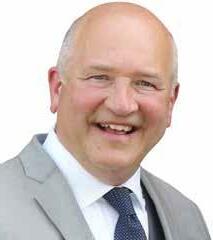
We have been very active in developing the new products and resources it takes to support such dynamic change. From the free-with-membership resources, like IIAR’s online training, to the new digital platform housing IIAR’s standards, publications, and other educational material, people are taking advantage of the benefits of IIAR membership like never before.


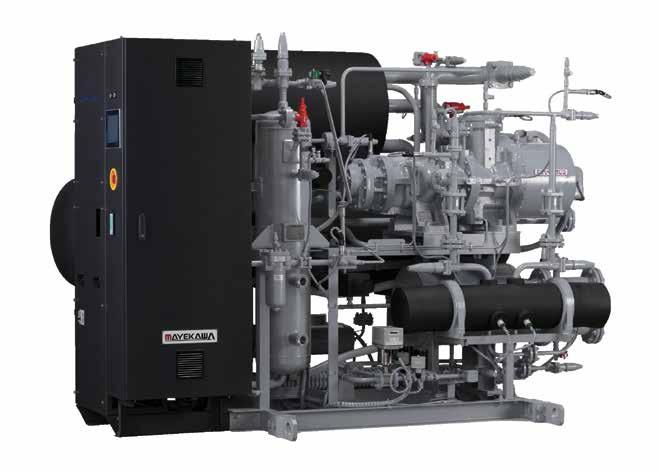
It seems like we were all just in Savannah, and now we’re look ing at starting another member ship year. That means we’re wrapping up preparations now for the next IIAR annual confer ence, in Long Beach, Calif., March 1215, and I’m approaching the last annual meeting during my term as Chairman.
In each membership year, the annual conference is the place to kick off new programs and initiatives for the year
Through the work of this task force, every one of our members is in a posi tion to influence the greater adoption of ammonia refrigeration.
Now is the time to educate anyone outside our IIAR membership and our circle of influence. We can teach about our systems by talking about how good they are for the environment; how effi cient they are and how safe they can be.
I also want to use this opportunity to thank all our IIAR committees for the

incorporate it into IIAR standards, bul letin documentation, and other practical, usable documentation for the everyday operation of our systems.
My hope for the future is that we will be able to use the new Hydraulic Shock Task Force as a model for the conversion of information yielded by other Founda tion research projects – into real, action able information that can be incorporat ed into IIAR materials to help us design and operate even safer systems.
As IIAR members, the programs we support are made possible by the hard work of our committees and the volunteer members who run them. IIAR continues to focus on providing our members with the safety standards, regulatory support, industry technology, and other member services that are nec essary to operate an ammonia system in today’s environment.
Each opportunity for sharing knowl edge and information, such as our annual conference, our Academy of Natural Refrigerants program, and the many other IIAR initiatives we advance every day, is a chance for us to build and strengthen the resources we have available for our members.
ahead. In 2021 we met several impor tant goals, even as we were meeting remotely, and this year, our return to in-person conferences marked the begin ning of a new slate of initiatives led by IIAR members.
As your IIAR Chair this year, my ma jor initiative has been to help lead the formation of an AIM Task Force to help learn more about the AIM Act’s require ments and how the association and its members can support the act.
This initiative is one of the most important activities IIAR can take on.
day-to-day grunt work they have done to get us to this point this year. Our safety standards, educational training, and many other activities led by com mittee members and staff have set us up well for the effort to come.
In addition to the AIM Act Task Force, I’m proud of several other activities IIAR pushed forward this year. One of them is a newly created Hydraulic Shock Task Force which will take hydraulic shock research produced by the Natural Refrigeration Foundation, (formerly, the Ammonia Refrigeration Foundation) and
We are constantly at work, develop ing the world’s largest and best informa tion resource for our membership and the industry in general. One of the best parts of being IIAR’s Chairman over the past year has been the opportunity to be part of this work.
Although we are still months away from our next meeting, I am already look ing forward to seeing many of you at the conference. And beyond that, I’m looking forward to seeing where the achievements of the past few years take us as we move toward the future of our industry.
Now is the time to educate anyone outside our IIAR membership and our circle of influence. We can teach about our systems by talking about how good they are for the environment; how efficient they are and how safe they can be.


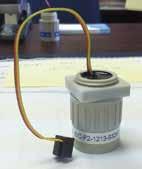


IIAR is moving closer to completing its first standard for hydrocarbons—such as propane and butane—in refrigeration systems and is hoping to release the standard for public review in early 2023.
“It is a complex process to develop a safety standard for multiple applications of a refrigerant of this level,” said Charles Hon, manager, engineering, sustainability, and government affairs, True Manufacturing Co. Inc.

The committee has completed its initial draft and submitted it to the entire hydrocarbon task force for comments. “We’ve addressed those oneby-one and have one set of comments left to address,” said Peter Jordan,


senior principal engineer at MBD Risk Management Services Inc.
The task force has also released the standard for a pre-public review to select individuals and the Standards Committee and is addressing those comments. “We are going to a few key players in the industry and letting them see it first. They’re the ones that are coming up with the most beneficial comments,” Hon said.
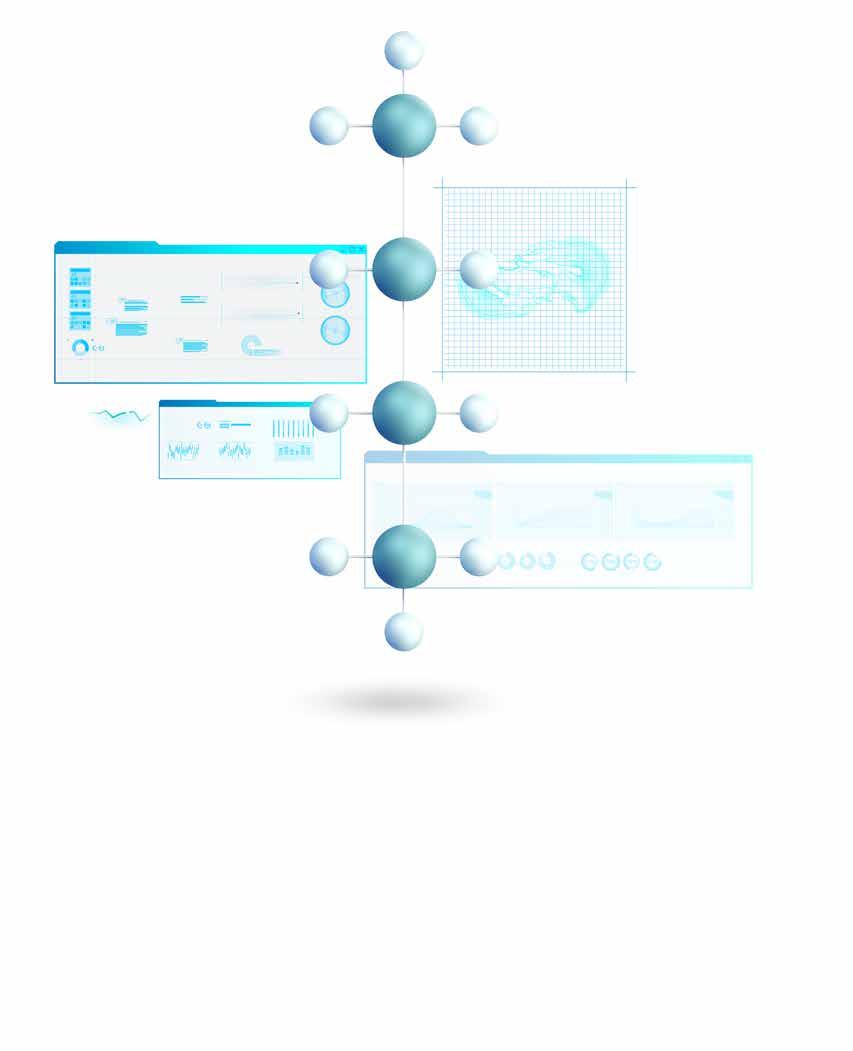
Trevor Hegg, vice president of product development, industrial refrigeration, and water systems, Evapco Inc., said the goal is to make the public review period more manageable. “When we wrote the CO2 standard,
we went through a pre-public review. It really helped bring down the number of comments in the public review because it vetted out a lot of things we weren’t aware of,” he said. “It smooths out the process when the first document hits the streets for public review since it is in better condition and, therefore, receives fewer comments.”
Jordan added that most of the comments received so far have been very useful and very thought-provoking. Most of the comments so far are dissecting the regulation and comparing it to existing codes and standards. “This standard will have to parallel the ASHRAE 15 standard, which is



With durable Vilter industrial compressors in your cold chain processes, you always gain an advantage in reliability. The proven Vilter Single-Screw Compressor design, with balanced loads across critical internal components, leads to improved uptime always performing in your most demanding applications. Look to Vilter for your always answer to industrial compression.

basically building code requirements used by fire marshals. We’ll have to be in tight sync with it,” Hon said.
Other commenters have asked if it should be broken into sections to make the nearly 400-page document more manageable.
Hon said the committee is targeting early 2023 for a public review period, which could last 30, 45, or 60 days. Then those comments come back to the committee for review and verification.
“The committees work hard to address comments quickly,” Hegg
“That can take another extended period of time.”
Hon added that many states right now are passing laws that say that any refrigerant that is SNAP-approved can be applied in all applications under building codes. “That will be a major impact. Building codes are often 8-10 years behind the times and would then be overwritten by state law,” he said.
The petrochemical industry has a long history of using hydrocarbons, and they are increasingly being used in some refrigeration applications where other
refrigeration effect. ISO 60335-2-89 covers international requirements for use of HCs in refrigeration systems and has voted to raise the charge limit to 500 grams per circuit in self-contained units with some limitations.
Hydrocarbons are also used in industrial settings, such as refineries or major refrigeration facilities. “Those charge sizes are very large, but getting down to the next major group, such as the grocery stores, requires a new thought pattern because we’ve never had a high-flammability refrigerant used in those applications before,” Hon said. “It is a major step that will have a major impact on how grocery stores are designed and built.”
Hegg said the hope is that a standard will allow systems to expand in size and quantity of refrigerant. “That doesn’t happen unless you have standards in place to help guide people on safe systems,” he said.
Jordan said he expects the use of hydrocarbons to continue to grow and it could work alongside other refrigerants. “The primary refrigerant would be the hydrocarbon, and we anticipate that in certain cases, a secondary refrigerant would be used,” he said.
said. “A lot of times the received comments are distributed between the subcommittee members who will look at them and attempt to address them, then the subcommittee as a whole will review each individual member’s suggested response.”
Hegg noted that committees are made up of volunteers who try to move the process along. “We don’t like it lingering. We want to get back to commenters, and we want to get the document published as fast as possible, too,” he said.
Because this is a new standard, it will probably include a second public review. “For a new standard, you sometimes do three or four reviews,” Hon said, adding that hydrocarbons have incredible efficiency potential but also have a lot of safety considerations. “As such, we’re being pretty cautious.
Once the standard is final, IIAR will work with the EPA SNAP group to get approval. “They want a final standard before they will discuss it,” Hon said.
refrigerants are not allowed, are difficult to use, or are inefficient.
For IIAR, developing a hydrocarbon standard was a natural extension of the association’s mission to offer safe practice standards for other natural refrigerants as the use of low globalwarming-potential refrigerants grows. “We’ve been widely recognized for our work on ammonia and recently completed work on CO2. The other natural refrigerants getting attention are hydrocarbons,” Hegg said.
The hydrocarbon standard follows a similar framework as the IIAR CO2 standard with sections on design, installation, startup, inspection, testing, and maintenance, as well as general safety and training needs. Plus, it is a complementary standard to ammonia and CO2.
Hydrocarbons are allowed today in self-contained systems with less than 150 grams of charge per circuit. 150 grams of propane is sufficient to produce approximately ½ ton
A hydrocarbon standard is becoming even more critical as the government, industry and private entities address refrigerants. “With all of the changing regulations we’re seeing right now—the AIM ACT reducing HFCs and the global warming discussions from state and federal regulators so the U.S. can meet the Kigali amendment, this is one of the steps that has to be taken,” Hon said. “These are all drivers behind it, and we knew they were coming. Now they are real.”
Hegg said IIAR members are excited about the new standard. “When you think of a 400-page document, there are a lot of people making a lot of contributions to it. It also speaks to the enthusiasm behind it,” he said, adding that the committee has put in a lot of work over the last couple of years.
Even more importantly, natural refrigerants overall are drawing more interest. Hegg added that the standards committee continues to grow, and new members are joining and contributing. “It is exciting to see this level of enthusiasm for natural refrigerants,” he said.
The petrochemical industry has a long history of using hydrocarbons, and they are increasingly being used in some refrigeration applications where other refrigerants are not allowed, are difficult to use, or are inefficient.
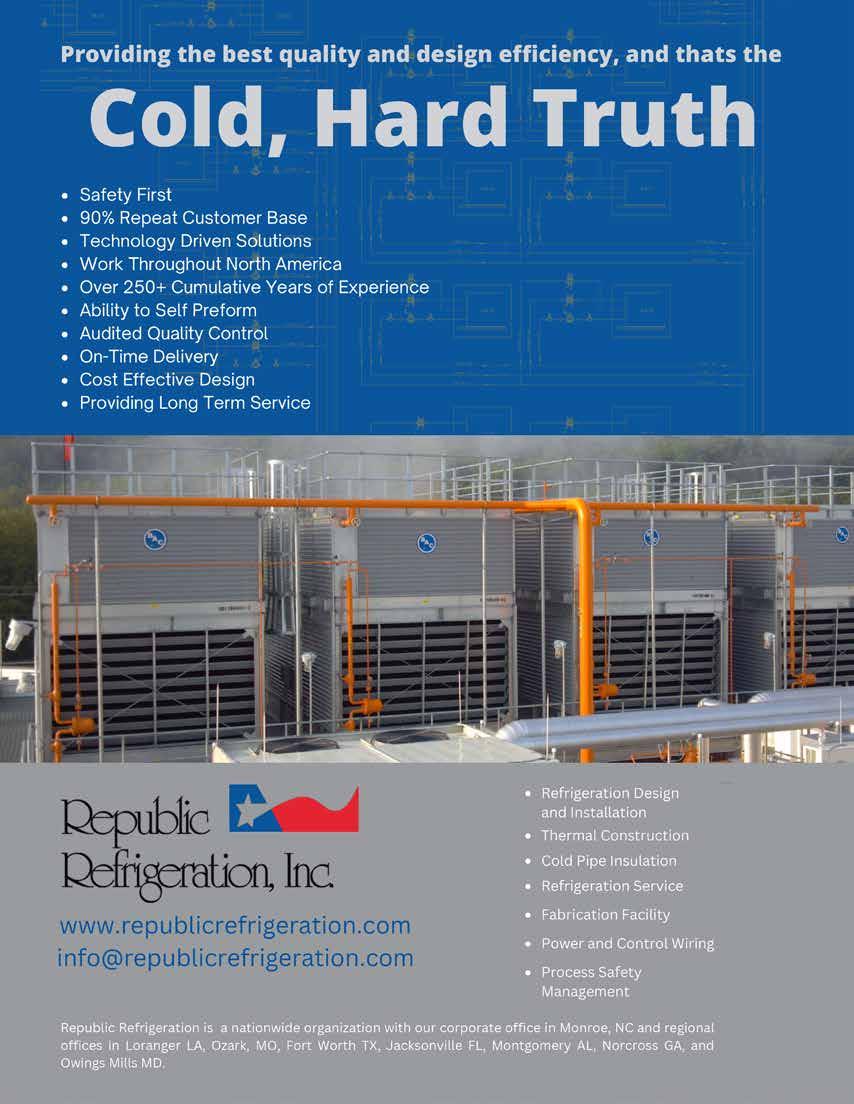
IIAR reviews and updates existing standards every five years for periodic maintenance and has recently released updates on IIAR 1 and IIAR 3. The periodic maintenance reviews and updates meet the “Procedures for the Development of IIAR Standards for ANSI Approval” and ANSI’s Essential Requirements.
ANSI/IIAR 1 provides a unified set of definitions for use in the IIAR standards. “There are nine other standards in the suite of IIAR standards and each of those subcommittees pretty much at their discretion get to introduce terms and definitions as they apply to
contractors, end users, and authorities having jurisdiction,” he said.
The committee was presented with 99 new definitions from the previous group in the previous five years. Seven definitions were modifications of existing definitions and 29 were duplicates.
In the new edition process, everything gets reviewed for compatibility with the other IIAR Standards. Any and all changes are communicated with the originating subcommittee chairs. “So, what we ended up with was about 50 new definitions and revisions of 10 existing definitions in the 2022 edition, ” Merrill said.
minimum performance criteria that valves and strainers are required to meet if used in an ammonia refrigeration system.
The IIAR 3 standard was originally released in 2001. Prior, periodic revisions of the standard saw sporadic participation by valve manufacturers and end-users. For this revision, three valve manufacturers and a number of system designers and end users joined the subcommittee and participated fully through its entire development.
The revision was ultimately 30 pages long and entirely addressed IIAR 3’s purpose - to provide the minimum performance criteria that valves and strainers are required to meet if used in an ammonia refrigeration system.
their particular standard. Sometimes they’ll pick a term, and they want to make sure it is clear exactly what that term means,” said Rich Merrill, IIAR 1 Subcommittee chair.
Merrill said IIAR has introduced several new standards in the last five years, which have added definitions. “Those definitions get published and get reviewed by the public when they introduce new standards. Then, we pull those definitions into our five-year update and publish them there,” he said. “What we first have to do is to make sure that word that they define is used with the exact same meaning in all the other nine standards so that IIAR 1 speaks to definitions in all of the other nine standards.”
Definitions are introduced and approved as well as removed from the IIAR-1 standard during regular reviews. Tony Lundell, director of standards and safety for IIAR, said standards must be clear. “A set of common definitions is provided to give clarity to engineers,
Before the new edition could be considered complete, it had to go through one pre-public and two public reviews, where comments received had to be addressed to the satisfaction of the commenters.
Lundell praised Rich Merrill for his diligence and teamwork to bring this revision in.
During the IIAR Board Meetings in New Orleans in late October, the IIAR Standards Committee and IIAR Board of Directors voted to approve IIAR 1-2022, and ANSI’s Board of Standard’s Review (BSR) approved IIAR 1-2022 on October 31. ANSI/IIAR 1-2022 was posted in the ANSI Standards Action Schedule on November 11.
Updates to IIAR-3 American National Standard for Ammonia Refrigeration Valves were a “win-win for the valve manufacturers and valve users,” Lundell said. IIAR 3’s purpose is to provide the
Major changes included more clarity on seal caps (in Section 5.11), adding a definition of a pressure-containing seal cap. The new edition also included several updates in Chapter 7, pressure envelope requirements. In Chapter 8, sections 8.1 and 8.2 were consolidated into one section, and IIAR added more specific requirements to better align with industry-standard norms and practices. Chapter 9, section 9.4.3 now includes varying levels of seat leakage classes and a lower, more reasonable amount of maximum leakage allowed.
Lundell said consensus for the 2022 revision took more work and effort than originally thought, and praised IIAR 3 Subcommittee Chair Mike Trumbower, senior engineer at Parker Hannifin Corp., for his efforts.
“I can tell you that the review and revision discussions with getting the manufacturer’s full input, which was absolutely what we needed and wanted, took longer to finalize some sections versus others,” Lundell said. “Mike helped work through the discussions to reach a consensus that was practical, doable, and realistic.”
ANSI/IIAR 3-2022 was ANSI Approved on July 11 and published on September 16.
Merrill praised Lundell for his work throughout the revision process. “He does all the difficult negotiations with commenters and all the bureaucratic work with the people at ANSI for all our standards,” he said.
In the new edition process, everything gets reviewed for compatibility with the other IIAR Standards. Any and all changes are communicated with the originating subcommittee chairs.
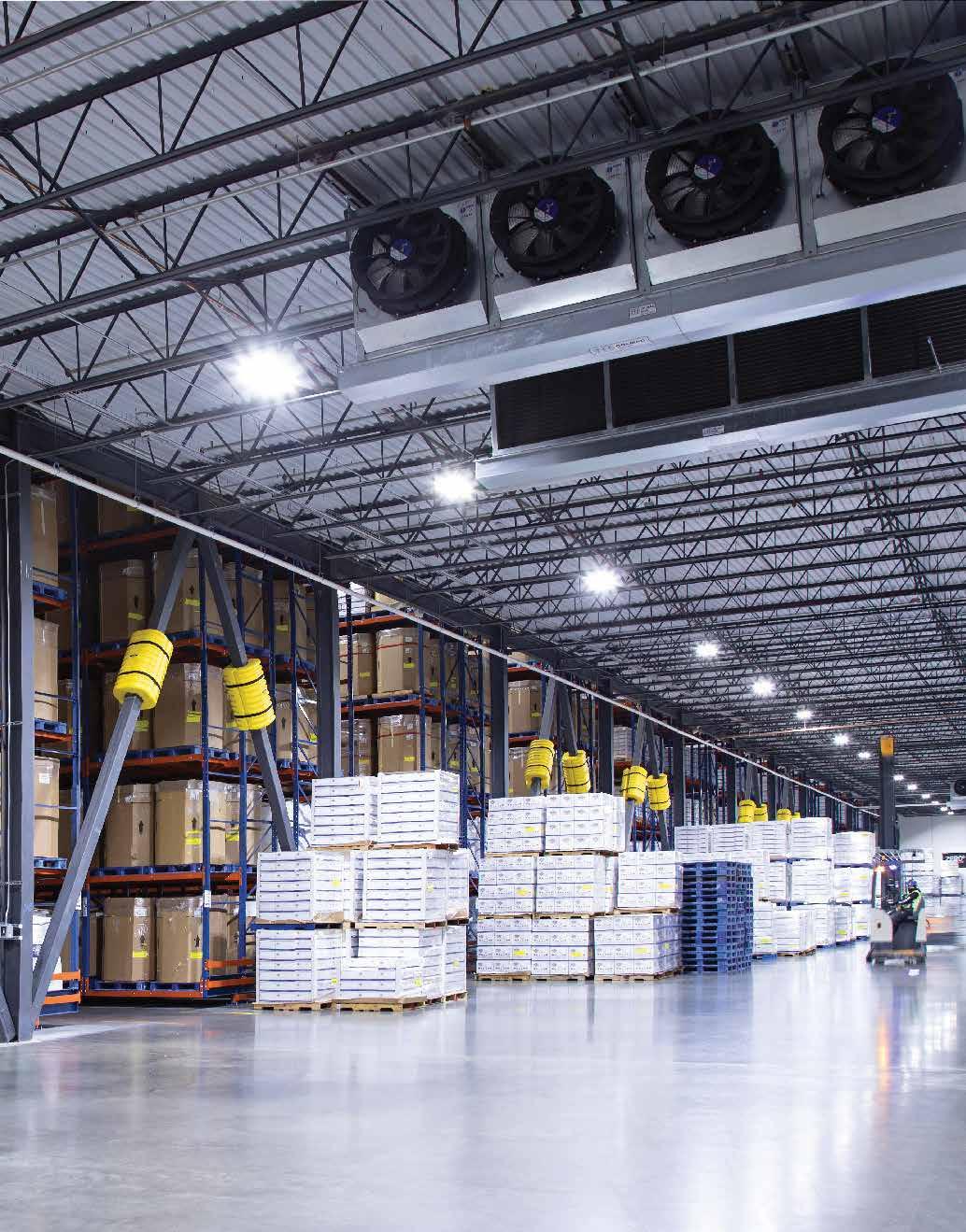
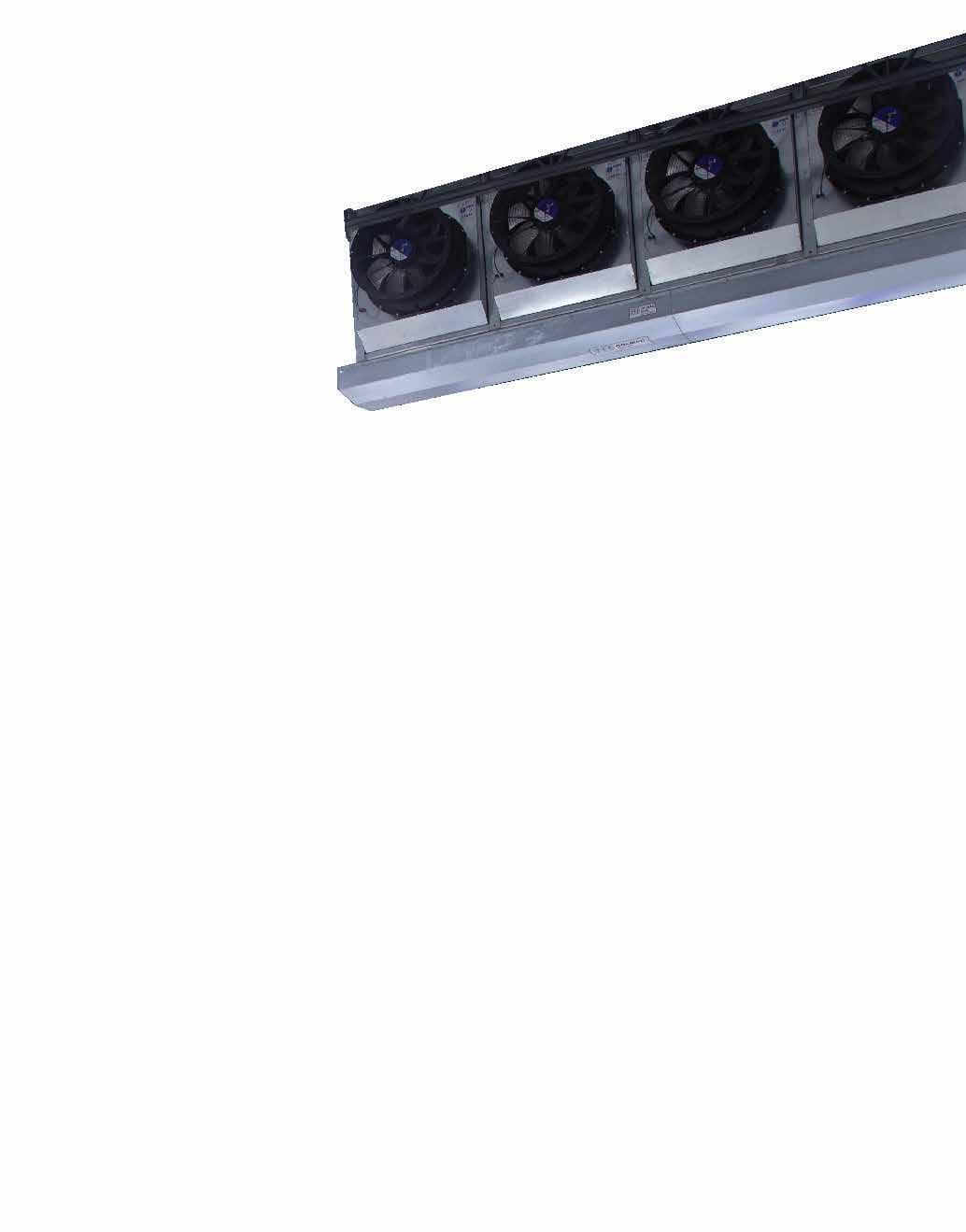




The recent IIAR Seminar for Latin America in Guadala jara, Mexico, August 2426, brought together nearly 400 manufacturers, con tractors, and end users from 12 coun tries for a unique opportunity to meet, learn and do business. Attendees took part in 14 technical paper presentations, five technomercials, networking events, and a heavy equipment exhibition. The event is the only one of its kind in the world outside the U.S. and is the most attended event in Latin America.
The refrigeration industry in Mexico is in full swing, and a similar rhythm is palpable in many other Latin American entities that understand the importance of eco-friendly natural refrigerants. The

growth in the area has been so positive that many manufacturers have been installing plants in the region, making prices more accessible and keeping enduser facilities in better condition with contractors who service faster counting with spare parts without delay. The ongoing interest in and growth of natu ral refrigerants in Latin America made this an ideal time to present the 2022 seminar.
The event was hosted by members of the Mexico Chapter of IIAR headed by Josué Castro. IIAR’s International Committee Chair Max Duarte also attended the event along with IIAR’s International Director Yesenia Rector and the IIAR Latin American Administrator Federico Alarcón.
Directors of the firefighter department for the State of Jalisco and Zapopan city kicked off the activities and took part in the closing ceremony.
Pulling together an in-person event after the pandemic took courage, but the main players in the industry were supportive. Once the invitations were launched, there was a positive and immediate response from sponsors and exhibitors.
The subjects discussed revolved around energy efficiency, improvement in procedures, legal regulations, and presenting cutting-edge technologies. Experts from different parts of the world presented 14 high-quality technical papers. Topics included best practices in the application

of transcritical CO2 in industrial applications; safety valves, a review from the bases to the applicable legislation; and selection of flooded exchangers for ammonia and applications in the industry. Advansor, Bitzer Mexico, Danfoss, Frimont, and SRT presented technomercials.
With the event, which created a unique opportunity for manufacturers, end users, and contractors to meet, learn and do business, IIAR is keeping its promise to continue educating and reinforcing industrial refrigeration best practices in Latin America.
The event also featured networking opportunities and fun. Tibu Santillanes, a renowned musician, played saxophone during a meal. A dessert turned out to
be a surprise show and, at the end of the closing day, the rock band Stone Walkers played original and classic songs, which was in line with the theme of the Hard Rock Hotel that hosted the seminar for the second time.
Post-event attendee surveys were filled with positive comments about the event with participants noting they generated new leads and found new suppliers. The next IIAR Latin American Seminar will take place in 2024.

Almost 400 attendees 12 countries 20 states of the Mexican Republic 44% manufacturers, 28% end users,
and 27% contractors 14 sponsors 14 technical presentations
2 technical days 5 technomercials
5 coffee breaks
2 gourmet meals
Tibu Santillanes performance on the saxophone
Stone Walkers band performance

• Safety and efficiency
• Equipment reliability
• Norms and regulations
• Lower operating costs
• Hands-on practices
Industrial and commercial re frigeration systems use differ ent types of heat transfer fluids (HTF), many of which are toxic and/or bad for the environment when they leak. The most com mon HTF refrigerants are Ammonia and hydrofluorocarbons (HFC), however while ammonia has a Global Warming Potential (GWP) of 0, the HFC’s all have a very high GWPs and are currently being evaluated by the EPA for phase down as per the US Government’s December 2020 AIM Act and per the recent United States ratification of the Kigali agreement. Newly developed hyrofluoroolefins (HFO) have a lower GWP, but their flammability will need to be considered when they are integrated into the refrigeration industry.
Water combined with antifreeze solu tions (such as ethylene glycol), ammonia, and liquid nitrogen are each commonly used refrigerants, keeping everything from people to perishable foods, cool and fresh. Liquid refrigerants must be carefully handled and closely monitored, whether being used for a commercial HVAC sys tem or industrial refrigeration, because if a
The Gainesville tragedy is a stark reminder of the potential danger as sociated with refrigerants. And while it may seem unlikely, the dangers are just as real inside the mechanical room of a Grade A commercial complex as they are inside the machinery room of an industrial food processing plant.
A building’s mechanical room is the hub of its heating, ventilation, and air conditioning (HVAC) system. Mechani cal rooms have numerous components, each of which can generate leaks and other issues, and may include some or all of the following: air handlers, boilers, chillers, heat-exchangers, water heaters, tanks and pumps, backup gen erators and elevator machinery. For this reason, a building’s mechanical room is often considered the heart of a build ing, 2 and its safe operations are critical.
A mechanical room’s refrigeration equipment requires special attention because of its potential to leak potentially toxic and environmentally harmful refrigerant gases. Although some refrigerants have relatively low toxicity, at high concentrations they can displace oxygen. Severe or prolonged oxygen deficiency can lead to a worker’s serious injury and even death. Not only dangerous to worker health and safety, synthetic refrigerants are also controlled substances regulated by the Environmental Protection Agency (EPA) because they are considered harmful to the environment, as many refrigerants are categorized as ozone-depleting or high global warming substances. 3
jurisdictions.) These standards outline the proper use of equipment containing refrigerants, the amount of charge for specific refrigerants, and the safe exposure limits to refrigerant gases.4
According to IIAR 2 standards, at least one ammonia detector needs to be in a machinery room, with audio and visual alarms sounding both inside and outside the room. An alarm is required to be set at a maximum of 25 ppm, with ventilation being engaged at no higher than 150 ppm. This is where a safety controller, which manages detection devices and receives alarm information and even sensor vitality data, plays a central role. Modern safety controllers are now masterless systems with modular, plug & play modules that do not require programming and can be hot swapped. These controllers can automatically engage ventilation systems, audio and visual alarms, and even send out text messages and emails when an incident occurs. It is highly recommended that the IIAR 2 standard be reviewed to make sure that all the safety requirements are properly implemented.
leak occurs, these toxic gases can quickly become lethal. In fact, in January 2021, six workers at a poultry processing plant in Gainesville, Georgia died as a result of a liquid nitrogen leak.1
Industry standards provide guidelines for mechanical room operators or any person who might require access to a building’s mechanical room or its refrigerant equipment where harmful gases might be present – applicable standards include ASHRAE (American Society of Heating, Refrigerating and Air-Conditioning Engineers) 15 and 34, IIAR 2 for ammonia systems in the US, EN 378 throughout the European Union, and CSA-B52 in Canada. (Other regional and state regulations may be applicable in certain
In addition to addressing the physical hazards of commercial HVAC and refrigeration systems, ASHRAE and other safety standards also stipulate the use of refrigerant gas leak detectors in mechanical rooms for commercial cooling systems with charges greater than 6.6 lbs. (3 kg) of CFC, HFC or HFO type refrigerants. EN 378 has slightly larger charge allowances.4 It’s worth noting that systems using HFO refrigerants will sometimes require detection and ventilation whether they are in a machinery room or not.
ASHRAE 15 specifically states that, 1) Each machinery room shall contain a detector located where a refrigerant leak would concentrate; and 2) The detector shall trigger an audible and visual alarm both inside and outside the mechanical room and activate mechanical ventilation.
Early detection of refrigerant leaks is essential for a variety of reasons, not the least of which is the protection of workers’ health and safety.

• Protect Health and Safety – If a piece of commercial HVACR equipment experienced a sizeable break, or fissure, it would cause an immediate and dangerous refrigerant leak, but equally dangerous are the smaller, slower leaks that could easily go undetected. A slow seeping of toxic gas within an enclosed space can accumulate to dangerous concentration levels over time. Extended exposure to refrigerants can cause adverse cardio and neurologic health effects and in higher concentrations even cause asphyxiation. Gas detection devices provide workers an early warning of potential danger.


• Reduce Waste – Synthetic refrigerants are expensive, so a leak of any scale can be costly to a commercial enterprise. Refrigerant loss can also affect a system’s operating efficiency and risk the loss of salable products. The sooner a leak is detected, the sooner it can be repaired, and any waste and economic loss mitigated.
• Minimize Refrigerant Emissions – EPA standards dictate that mechanical rooms use detectors to minimize refrigerant leaks and protect the environment from harmful emissions. To remain compliant, commercial buildings must have specialized detection systems capable of identifying low level leaks.


•
–
Every operations manager knows an emergency or unforeseen system outage is costlier and more inconvenient than a planned shutdown for scheduled maintenance or testing. Early leak detection allows maintenance workers to intentionally shut down and shore up their system until they can adequately plan to repair leaks or replace damaged equipment.
For mechanical room operators –whose job it is to select an appropriate and effective gas detection system for their unique space and HVACR system – it is important to understand the distinction between refrigerant gas detection for the purpose of protecting workers’ safety and early leak detection for the purpose of reducing refrigerant emissions and satisfying environmental regulatory standards.4


Diffusion-style gas detectors are typically used to meet mechanical room safety requirements. They are common ly wall-mounted; thus, a gas leak must travel to reach the sensor element. Nat urally, gases become less concentrated as they move from the point of a leak to the location of gas detection, but once sensors detect even low concentrations, detectors will quickly sound an alarm. It is important to install diffusion style detectors in the proper location and height, depending on the application and gas type that is being monitored.
Diffusion detectors often include a gas sensor with a lower detection limit (LDL) of 20 ppm and preset alarm settings of 15% to 100% of the full-scale range. An early low alarm warning level reduces false alarms while still providing for a
safety factor before reaching the thresh old of the occupation exposure limit (OEL) which is the setpoint of the typical high alarm setting.4

Leak detectors are designed to warn technicians or other commercial build ing employees that refrigerant gases exceed safe concentration levels before they enter a mechanical or machinery room. As previously noted, ASHRAE guidelines stipulate that to protect work ers a gas detector should be located in an area where the refrigerant gas from a leak will concentrate. Additionally, gas detectors must set off an audible and visual alarm and automatically trigger mechanical ventilation.
While diffusion-style detectors identify higher gas concentrations and comply with safety guidelines set forth
by ASHRAE and other industry regula tors, they are insufficient at detecting low-level leaks. Ultra-sensitive gas sampling systems provide continuous monitoring of air quality, and thus can provide early warning of smaller refrig erant leaks that contribute to harmful refrigerant emissions.
Sampling systems use sensitive, centralized photoacoustic infrared gas sensors with an LDL as low as 1 ppm. A pump is used to draw samples from points as close as possible to a potential leak source – for example, coils or com
tions. When evaluating systems, it is important to examine key capabilities. Here are few critical considerations:
• Is the monitoring system compliant with standards?
• At what ppm level does the detector register the presence of gas?
• Are the sensors specific to the target gas and not cross sensitive to other gases such as cleaning agents?
• Does the system include multi-point monitoring? Can it be expanded?
expect an LDL (Lower Detection Limit) of 20 ppm with a range of 0-2000 ppm. Another sensor technology using catalytic beads can detect ammonia and other combustible gases from 0-100% LEL (Lower Explosive Limit). There are other technologies such as MOS (Metal Oxide Semiconductor) which are lower cost but are not specific to refrigerants and can generate false alarms due to cross interference with common household cleaners. It is important to meet with a gas detection consultant to determine which sensors are needed and where to place them, which is determined by the application.
pressors, to the sensor. Such sequential sampling systems are ideal for com mercial building applications where there are multiple, dispersed sources of potential leaks and where gases can become quickly diffused in the large spaces.
Photoacoustic infrared based sam pling systems are also recommended for detection of refrigerants such as R123 where the required alarm setpoints are lower than the LDL of diffusion style gas sensors.
It would not be practical for a mechani cal room operator to only monitor for low level refrigerant leaks and neglect methods that warn of a build-up of higher gas concentrations – nor would it be prudent to focus only on worker safety and ignore EPA compliance. Instead, commercial mechanical rooms must have a robust gas detection system capable of effectively and efficiently per forming both monitoring methods.
Multiple manufacturers offer a vari ety of refrigerant gas detector and mon itoring systems designed for refrigerant applications in mechanical rooms. They all have their advantages and limita
• Does the controller have multiple relays for fault and alarm alerts, as well as connection to a visual and audible alarm required by standards?
• Does the system controller include integrated BACnet or Modbus for direct digital communication to the facility’s building management or refrigeration control system?
• Is the system intelligent enough to include plug-and-play capability, eliminating the need for timeconsuming configuration.3
• Does the manufacturer offer factory trained and authorized on site commissioning and preventative maintenance service?
There are a variety of gas detection instruments – from personal portable detection devices to wall-mounted stationary units. The purpose of fixed gas detection in these applications is to alert workers of a dangerous situation before they enter and while working in the space. HFC, HCFC, and HFO refrigerants are usually detected using NDIR (Non-Dispersive Infrared) sensors and Photoacoustic IR sensors. Depending on the performance capabilities of the sensor, one can
Refrigerant gases can be toxic to workers and damaging to the environment. Thus, refrigerant gas safety is important – not just in industrial settings, but in commercial environments as well. Gas monitoring is essential to protect the health and safety of workers, to mitigate costly leaks and potential emergency shutdowns, and to reduce harmful emissions and comply with environmental regulations. Both safety and emissions matter, so gas detection systems must address small, moderate, and high-level leaks.
Mark Heuchert serves as Marketing Manager, North American region, for Dräger, an international leader in the fields of medical and safety technology.
1 https://www.nytimes.com/2021/01/28/us/ foundation-food-group-liquid-nitrogen-plant. html
2 https://www.us.jll.com/en/views/anexceptional-mechanical-room-shares-a-frontof-house-mindset
3 https://www.ishn.com/articles/108548control-refrigerant-gas-in-hvac-mechanicalequipment-rooms
4 https://ss-usa.s3.amazonaws. com/c/308475912/media/4680601c515 ebf80b79603880819469/Machinery%20 Rooms%20Whitepaper.pdf
https://www.honeywellanalytics.com/~/media/ honeywell-analytics/documents/english/ apn068_mechanicalrooms_web_10-15-14. pdf?la=en
Early detection of refrigerant leaks is essential for a variety of reasons, not the least of which is the protection of workers’ health and safety.
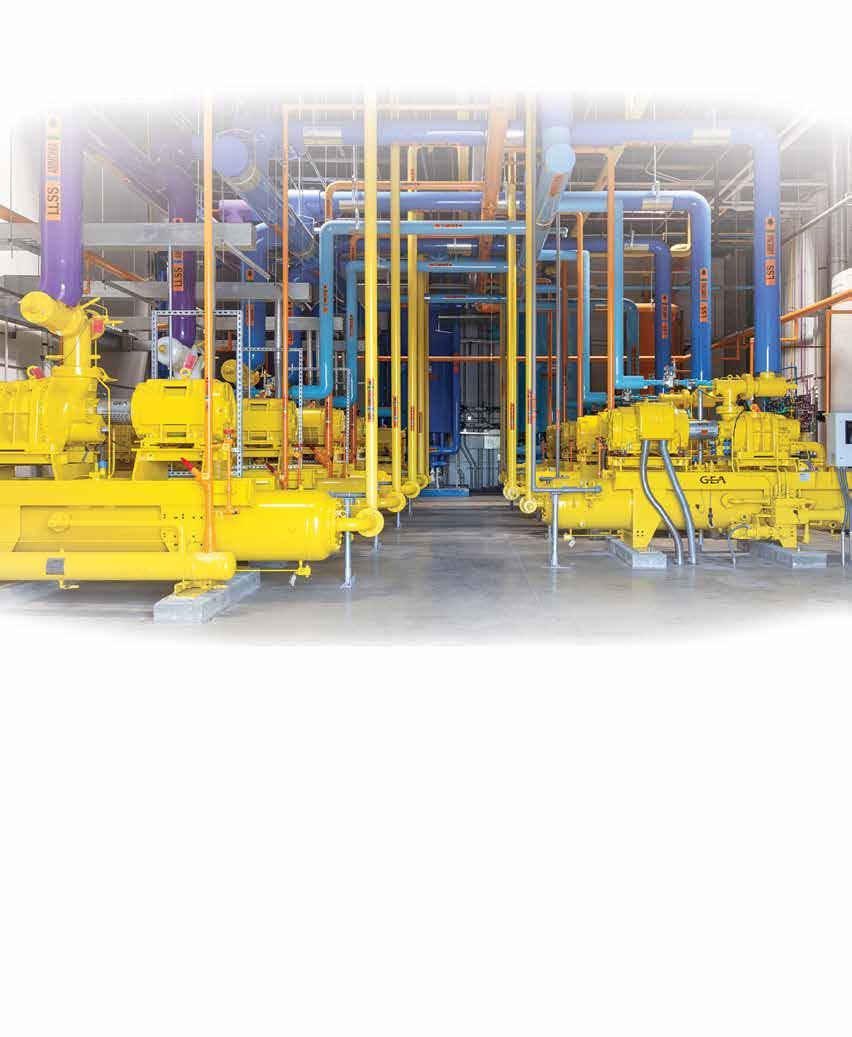
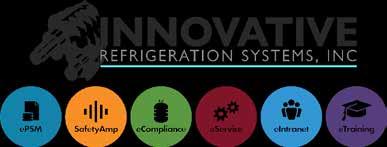



he Environmental Protection Agency has proposed amendments to its Risk Management Program regulations, which include several changes to the accident prevention program requirements, enhancements to the emergency preparedness requirements, and increased public availability of chemical hazard information.

“This is part of the back and forth of what the Obama Administration did, and the Trump Administration pulled back. Now the pendulum has swung back,” said Lowell Randel, director of government affairs for IIAR.
EPA has said the proposed amendments seek to improve chemical process safety and assist in planning, preparedness, and responding to RMP-reportable accidents. The agency also said the changes will improve public awareness of chemical hazards at regulated sources.
“Some of the proposed changes are reasonable and would be relatively easy
to implement, but others would require significant resources to implement,” said Peter Jordan, senior principal engineer at MBD Risk Management Services Inc.
IIAR has several concerns over the amendments and is leading a coalition, providing comments and recommendations to the rule maker and highlighting stakeholders’ concerns.
Randal noted that EPA is currently in the process of implementing the AIM Act, with the goal of phasing down the use of hydrofluorocarbons (HFCs), a common industrial refrigerant, but is also potentially discouraging the use of ammonia with its proposed rule.

“There are seemingly some competing priorities. On the one hand, they have the priority for phasing down HFCs, and in our mind, the most effective way to do that in the refrigeration sector is to have people move to natural refrigerants. That primarily is going to be ammonia,” Randel said. “At the
same time, they’re looking at increasing the burdens on an ammonia facility and that is sending a conflicting message.”
In its comments to EPA, IIAR noted that ammonia, which is subject to the RMP, is the most efficient and effective alternative for facilities considering a change from HFCs. “We are concerned that placing additional burdens on facilities choosing ammonia could dissuade some companies from moving away from HFCs and moving to natural refrigerants like ammonia. We urge the agency to consider the unintended consequences the Proposed Rule may have on moving facilities away from HFCs to ammonia,” IIAR said in the comments, which were also signed by the American Frozen Food Institute, Global Cold Chain Alliance, North American Meat Institute, and Refrigerating Engineers and Technicians Association. What’s more, IIAR is also concerned with the seemingly perpetual rulemaking related to the Risk Management Program. The industry has
been subject to back-and-forth changes over the last several years, which has challenged facilities’ understanding and planning for compliance. The Occupational Safety and Health Administration is also moving forward with potential changes to Process Safety Management. Randel urged EPA and OSHA to communicate as they move forward to avoid inconsistencies that could further complicate compliance.
One of the new additions to the proposed rule would require an evaluation of natural hazards, including those resulting from climate change, and power loss when conducting hazard reviews and process hazard analyses, and justification when hazard evaluation recommendations are not adopted.
“The Biden Administration is trying to add climate change to all rulemakings. The way they are doing that with RMP is with natural hazards and the potential for power loss,” Randel said.
The proposed rule also has a requirement for pollution control or monitoring equipment to have backup or standby power systems. “This would presumably include ammonia detectors. In addition, there appears to be a requirement for perimeter monitoring with backup power,” Jordan said, adding that not many facilities have perimeter monitoring.
In its comments, IIAR noted that requiring outside “perimeter monitor technologies” would not be a worthwhile expense or result in any actionable information and should be deleted from the provision.
The proposed regulation would create a third-party audit for facilities after two accidental releases within a five-year period, after one RMP-reportable accident for certain facilities, or if an inspector feels like there is a risk. “We think that is way too subjective,” Randel said.

The proposal also restricts which auditors could be used, restricting audits to only non-associated third parties, which would have a negative impact on facilities’ options. Randel said the restriction would disproportionately adversely affect businesses and facilities in remote areas because qualified “independent” auditors will be difficult to find, driving up audit costs.
In its comments to EPA, IIAR wrote, “The use of any qualified auditor should be at the discretion of the facility, including those who may be associated with the company, for such audits. This approach is consistent with the performance-based nature of the regulation.”
The association believes all qualified auditors, third-party or otherwise, should be allowed to conduct audits.
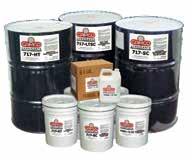
Under the proposed rule, facilities would be required to provide chemical hazard information, names of regulated substances, accident history, and
emergency response information for residents within six miles of the facility upon request as well as make it available in the language preferred by the requestor. In a fact sheet, EPA said it is “promoting environmental justice through increased availability of information.”
Randel said increasing how much and what types of information facilities must share is a concern. “These are critical infrastructure facilities and there are security concerns with providing a lot of facility-sensitive information to the general public. We feel like the proposal potentially makes some of those critical structure facilities more vulnerable,” he

said. “From my perspective, we’re in a less stable world than we would all like to be in, so we don’t want to make it even easier for someone who wants to be disruptive to our critical infrastructure.”
Employees would have a stop work provision, enabling employees to Refuse to perform a task when doing so could reasonably result in a catastrophic release, recommend to the operator in charge of a unit that an operation or process be partially or completely shut down, and allow a qualified operator in charge of a unit to partially or completely shut down an operation or process.
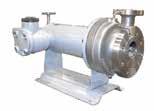
“A typical refrigeration system has an emergency stop button and facilities will have procedures which authorize trained employees to use it, but it sounds like the stop work procedures goes well beyond these procedures,” Jordan said.

While employees should not be required to do something that they know is dangerous or could lead to a catastrophic release, and they should have the ability to stop action that would lead to a potentially dangerous situation, Randel said there are problems with the proposed rule.
Employees need to be trained and qualified to make an informed and reasonable judgment on whether some action might lead to a release, whether catastrophic or not.
“PSM and RMP already require employees to be trained and qualified for whatever their job duties include. This provision could unintendedly encourage an employee to inappropriately refuse to perform a task that is within the scope of their assigned responsibility,” IIAR wrote in its comments.
The rule would also require an anonymous reporting mechanism, which is new. IIAR shared with EPA that anonymous reports can be very challenging and require someone to judge the validity of the report. “It is often necessary to clarify the concern in order to adequately address it. Potential exists for complaints from anonymous employees who may not fully understand the operation of the system in question or other factors,” according to IIAR’s comments. “Facilities having to address anonymous reports by misinformed persons could result in a large burden on the operation to appropriately address a complaint.”
Another new requirement of the proposed rule is that facilities retain hot work permits for five years. “Currently, there is no requirement to save hot work permits,” Jordan said.
While retaining hot work permits for some period of time is helpful, IIAR believes that five years is too long and would be overly burdensome. “We recommend that a one-year retention requirement is more appropriate,” IIAR wrote in the comments.
As EPA works towards its final rule, it will consider stakeholder comments. “These are proposed changes. EPA has to go through a formal comment period, and EPA must formally respond to the comments,” Jordan said.
Randel anticipates a final rule to be published in 2023 but said facilities will have time to prepare for mandated compliance deadlines, which are generally phased in over several years. “You’ll have some time to get your systems in place,” he said.
It is early to put a cost estimate on compliance, Randel said “it is obvious that these additional burdens will have a cost to regulated facilities.”
Honorable Michael S. Regan Administrator U.S. Environmental Protection Agency 1200 Pennsylvania Avenue, N.W. Washington, DC 20460-0001
Re: Comments for Docket Number: Docket ID No. EPA-HQ-OLEM-2022-0174 Accidental Release Preven tion Requirements: Risk Management Programs Under the Clean Air Act; Safer Communities by Chemical Accident Prevention
Dear Administrator Regan,
The undersigned organizations submit these comments regarding Docket ID No. EPA-HQ- OLEM-2022-0174 Accidental Release Prevention Requirements: Risk Management Programs Under the Clean Air Act; Safer Communities by Chemi cal Accident Prevention (Proposed Rule). The organizations represent thousands of facilities across the nation covered by Risk Management Program (RMP) regulations. In addition, the International Institute of Ammonia Refrigeration (IIAR) is an ANSI accredited standards writing body whose standards are widely used as Recognized and Generally Accepted Good Engineer ing Practices (RAGAGEP) as approved by a facility or authority having jurisdiction. The proposed revisions are of great inter est and concern to our organizations and member companies, and we appreciate the opportunity to provide comment.
Before addressing specific comments about the Proposed Rule, we would like to raise some general concerns. The agency is currently in the process of implement ing the AIM Act, with the goal of phasing down the use of hydrofluorocarbons (HFCs), a common industrial refrigerant.
Ammonia, which is subject to the Risk Management Program, is the most ef ficient and effective alternative for facilities considering a change from HFCs. We are concerned that placing additional burdens on facilities choosing ammonia could dis suade some companies from moving away from HFCs and moving to natural refrig erants like ammonia. We urge the agency to consider the unintended consequences the Proposed Rule may have on moving facilities away from HFCs to ammonia.
We are also concerned with the seem ingly perpetual rulemaking related to the Risk Management Program. Industry has
been subject to back-and-forth changes over the last several years, which has challenged facilities understanding and planning for compliance. The Occupa tional Safety and Health Administration (OSHA) is also moving forward with potential changes to Process Safety Man agement. Because these programs cover very similar elements, the undersigned organizations highly encourage the EPA and OSHA closely coordinate to avoid in consistencies that could further complicate compliance for industry.
Below are specific comments on the Proposed Rule.
While we agree that planning for potential natural hazards is important, we question whether additional emphasis on natural hazards is necessary within the regulation. Natural hazards have been and continue to be considered during a PHA that follows the IIAR suggested “What-if/Checklist” guidelines. IIAR Standards require safe ties to protect against any pressure event beyond acceptable limits, whatever the cause, either natural or manmade. Am monia refrigeration systems are designed for temperature increases that increase pressure. IIAR Standards also require ammonia detection and alarming with personnel being alerted for an unexpected release in a facility due to a natural event. IIAR Standards also require shutdown of equipment when a natural event causes a high-level condition in a system pressure vessel so equipment damage or a ammo nia release does not occur. IIAR Standards define many systems to both safely control and to shutdown systems.
We are also concerned that the pro posed definition of natural hazards is open
to interpretation, especially when it comes to hazards associated with climate change. Addressing climate change as a category is ambiguous and would make the PHA process unnecessarily more challenging.
In addition, controlling for all natural hazards (such as tornados) is impractical, if not impossible. For these reasons, we believe that natural hazards are already appropriately covered and additional regu latory language is not necessary.
We agree that facilities should have con tingency plans to handle potential power loss and IIAR addresses these issues in its standards and RMP guidance documents. However, the rule should recognize that the impact of power loss can vary among different types of facilities. For example, in a mechanical refrigeration system, a loss of power would result in stopping the only primary pressure producing equipment in a system, which is the compressor(s). Pres sures in the system will equalize to a pres sure corresponding to ambient conditions that should not result in a release. IIAR Standards provide that the design pressure of all pressure vessels “shall be equal to or greater than the pressure developed in the low-pressure side of the system from equal ization with the high side or heating due to changes in ambient temperature after a system has stopped.” This greatly reduces the chance of a release due to power loss.
We also believe that explicitly requiring standby or backup power is unnecessarily limiting in how a facility addresses poten tial power loss. Having standby power for an ammonia refrigeration system is not necessary because the loss of power should not lead to a refrigerant release, only loss of refrigeration. In addition, a requirement
to install backup power for ammonia detectors may be difficult for facilities to comply with as the detection system is connected to other safety systems such as alarms (strobes/horns) and the ventilation system. In order for the detection system to be meaningful during a power outage, the ventilation system and alarms would also need to be connected to the backup power supply. We suggest a change to the wording from “standby or backup power” to “a plan to account for loss of power.”
Location of a facility and its ammonia sys tem are already considerations in a facility’s emergency plan for notification of poten tially affected offsite populations, so includ ing this provision would reinforce the need for a thorough review of facility siting. This additional provision could negatively affect where facilities could be built, depending on the distance between a facility process and off-site populations. A policy restrict ing outside populations from building close to a facility which could interfere with real estate plans and impact local building regulations is highly encouraged.
Having external ammonia detectors is very ineffective due to changing wind directions and air temperatures and the physical characteristics of ammonia vapor, which is lighter than air, meaning it moves very quickly with air currents and goes up to dissipate in the atmosphere. Due to the physical characteristic of ammonia and the environmental conditions at the time of a release, ammonia vapor, which is lighter than air, will mostly go up (vertical), greatly limiting the ground level (horizontal) spread.
Transparency is highly appreciated and valued but publicly posting details on findings and recommendations to a mostly uneducated public is concerning and unset tling. PHAs and hazard reviews, along with the findings, are highly technical and complicated internal documents that can be easily misconstrued by the general pub lic that does not have sufficient technical understanding of industrial refrigeration systems to know if a recommendation, whether adopted or not, was appropriate. In addition, both the EPA & OSHA only allow facilities to reject a recommendation under strict conditions (i.e.,: (1) the analysis
upon which the recommendation is based contains factual errors; (2) the recommen dation is not necessary to protect the health of employees or contractors; (3) an alterna tive measure would provide a sufficient level of protection; or (4) the recommenda tion is infeasible.
Sharing such information with the general public could open facilities to unnecessary liability and create security vulnerabilities, particularly for chemicals of interest to the Department of Home land Security. We recommend that this information be made available to first responders and Local Emergency Planning Committees (LEPCs) upon request and with a meeting with those that created the information, but not made generally available.
While this proposed provision does not apply to ammonia refrigeration, the safer alternatives analysis requirements could ultimately be expanded to other industries.
The regulatory burden of requiring costly IST reviews tends to stifle innova tion. For those companies already looking to improve safety by implementing IST options, a formal IST review would add unnecessary costs to a process forcing ac tivities being performed to be document ed. Small operations might be manpower or expertise limited and lack the resources to cost effectively outsource.
For companies that do not implement IST options, the IST review becomes a “paper exercise” where they document why it is “infeasible” to implement these options. If RMP facilities are required to perform safer alternative options analyses and implementation plans, EPA should not require that the analyses and/or implemen tation plans be submitted to the agency. Likewise, EPA should not have any role in analyzing or approving such plans.
Root cause analysis in incident investiga tions is already included in the IIAR guide lines for industry. Additional regulatory language in this area seems unnecessary. If the agency moves forward, defining “rec ognized investigation method” is highly recommended Who is recognizing the “approved method”? Revising “recognized investigation method” (53,586) to “inves tigation method recognized by applicable
industry code writing or RAGAGEP estab lishing body” is strongly encouraged.
Audits are an important component of maintaining a safe facility. However, the proposal to restrict which auditors could be used after an accident is concerning. The use of any qualified auditor should be at the discretion of the facility, includ ing those who may be associated with the company, for such audits. This approach is consistent with the performance-based nature of the regulation. Auditor qualifica tions are much more important than “inde pendence” in meeting the agency’s goal of more effective audits and do not believe sufficient data has been produced justify ing the added cost the proposed restriction would impose on facilities.
Should the agency decide to require third party audits after reportable incidents, major revisions are needed to both the qualifications and independence requirements that have been proposed. Restricting audits to only non-associated third parties, will disproportionately adversely affect businesses and facilities in remote areas because qualified “in dependent” auditors will be difficult to find, driving up audit costs. Businesses and facilities in rural areas with access to qualified associated auditors should be allowed to use them because they are less able to absorb the significant costs of third-party audits done by non-associated third-party auditors.
Our experience observes that quali fied associated auditors in some cases can provide even more effective audits than non-associated auditors because non-asso ciated auditors may be less familiar with unique processes in an industrial refrigera tion facility. Qualified associated auditors will be more familiar with the systems and equipment in place and more capable identifying deficiencies and recommending appropriate corrective measures that are most applicable to industrial refrigeration systems. Focusing on the auditor’s qualifi cations and the core contents of acceptable audits will more likely result in the desired outcome.
The availability of qualified non-associ ated third-party auditors is also concern ing and is exacerbated by the agency’s proposal that contractors doing other work for a facility would be considered “associated” and not eligible to conduct
audits after an accident. Many busi nesses use the same contractor to assist in multiple ways, including audits. Denying them the ability to conduct audits severely restricts the pool of available auditors with relevant experience in the ammonia refrigeration industry. This restriction also places third party firms in the very difficult position of choosing whether they will be exclusively an auditing firm or a firm that provides a variety of value-added services. After speaking with third-party firms ac tive in the ammonia refrigeration industry, most third-party firms that conduct audits also provide other services. In fact, some of the third-party firms have indicated that they do not exclusively perform audits for any of their clients. The Proposed Rule would disqualify these very well qualified third-party firms from conducting audits after reportable accidents.
Another concern is the proposed restric tion on allowing the use of a third-party firm that employs anyone who has a finan cial connection with the facility, such as retirees. It is a common practice for third party auditors to hire people from facilities within the industry in which they conduct audits. Disallowing facilities to use these firms will make it even more difficult for facilities to find qualified third-party auditors that meet the “independence” re quirements. This problem is compounded for small businesses and facilities in rural areas where the number of non-associated auditors with experience in industrial re frigeration may be very small. The restric tions in the Proposed Rule would require these businesses to absorb even more costs by seeking non-associated auditors from outside their immediate facility location.
In summary, all qualified auditors, third-party or otherwise, should be al lowed to conduct audits. If the agency moves forward with its restrictive pro posal, permitting all qualified third-party auditing firms to conduct audits after an accident, regardless of whether they have done other work for the facility in ques tion, is strongly encourage. In addition, the presence of a retiree or other former employee should not disqualify the firm from conducting audits. Given the already limited pool of resources, qualified retirees and former employees provide added flex ibilities that would be particularly impor tant for businesses in rural areas, which comprise a large portion of our member companies.
Making audit findings available to the general public is still a major concern. Such a requirement would be extremely burdensome for minimal to no gain. For the public to understand the rationale of accepted or declined recommendations without sufficient knowledge of the pro cess would be extremely difficult and could cause security concerns, particularly for DHS Chemicals of Interest. Making audit findings available to first responders and LEPCs upon request and with discussion with auditors is the preferred approach. Lastly, the proposed provision stating that third-party audits could be triggered when “An implementing agency requires a third-party audit due to conditions at the stationary source that could lead to an accidental release of a regulated substance, or when a previous third-party audit failed to meet the competency or independence criteria of § 68.80(c)” is alarming. This appears to be a very subjective policy that is open to interpretation by individual inspectors that could be unevenly ap plied across different regions and states. Removing this provision, or, at minimum, establish a less subjective standard that can be more consistently and equitably admin istered would be more beneficial
Employee participation in PHAs is important but believe that this is already sufficiently covered by OSHA’s PSM policy in 1910.119(c)(2) which states: “Employ ers shall consult with employees and their representatives on the conduct and devel opment of process hazards analyses and on the development of the other elements of process safety management in this stan dard.” Adding this to the regulatory text for RMP is unnecessary.
We agree that employees should not be required to do something that they know is dangerous or could lead to a catastrophic release, and that they have ability to stop action that would lead to a potentially dangerous situation. However, an employee would need to be trained and qualified to make an informed and reasonable judge ment on whether some action might lead to a release, whether catastrophic or not. PSM and RMP already require employees to be trained and qualified for whatever
their job duties include. This provision could unintendedly encourage an employee to inappropriately refuse to perform a task that is within the scope of their assigned responsibility.
We also believe that more specificity is needed in the level of event that would trigger requirements to respond in writing within 30 days. We recommend deleting “reports of hazards” in (53,592).
We agree that employees should know that they can voice a concern verbally or in writing without fear of repercussions. However, anonymous reports can be very challenging and require someone judg ing the validity of the report. It is often necessary to clarify the concern in order to adequately address it. Potential exists for complaints from anonymous employees who may not fully understand the op eration of the system in question or other factors. Facilities having to address anony mous reports by misinformed persons could result in a large burden on the opera tion to appropriately address a complaint. Methods and time frames would need to be developed to determine if a report had any credibility and when appropriate actions should be taken.
The current RMP program sufficiently ad dresses the needs of detectors and perimeter monitors.
7.4.G of the RMP eSubmit defines the “process area detectors” and “perimeter monitor” technologies. In the case of ammonia refrigeration, perimeter monitor ing does not add additional information beyond the detectors specified in IIAR 9-2020. Due to the characteristics of ammonia being lighter than air, it would be extremely unlikely to detect a release around the perimeter of a facility. Requir ing outside “perimeter monitor technolo gies” would not be a worthwhile expense or result in any actionable information and should be deleted from the provision. Alternatively, it would be acceptable to reword “their process area detectors and perimeter monitor technologies and mod els in use to detect” to “effective means to monitor levels of.” (53,595)
The proposed language also seems to place unnecessary burden on improving com munity notification systems on facilities instead of relying on community agen cies, where this authority lies. Having an external notification procedure described in their emergency plan is appropriate but notification to offsite populations should come from a “community” organization that works closely with the facility. A facil ity having a notification system alerting the public, independent of a community notification system, could cause coordina tion and appropriate action problems. We suggest changing “and ensure that” to “and partner to ensure that” (53,596).
Strong coordination and collaboration between the facility and local responders is critical for effective community notifica tion. Facilities and local responders must work together to lessen the likelihood of off-site impacts. We recommend that local responders coordinate with facilities and request the necessary information they need to properly respond to an emergency and notify the public.
We agree that facilities should understand what the community plan does and does not do regarding a release. However, in many areas, community plans are very dif ficult to access. Community plans should be publicly available, but finding them has proven to be challenging. This is even more problematic in rural/remote areas where LEPCs are already overwhelmed and under-resourced, or in some cases inactive. The proposed policy also raised the question of how facilities should react if deficiencies are found in the community plan. If a facility identifies that the local plan is deficient, they must come up with a creditable response plan which seems ap propriate. However, an unrealistic burden could be placed on facilities where there is no organization or group in their local area that can appropriately respond depending on what is needed for a proper response.
This potentially could force a facility to have an emergency response plan, not just an emergency action plan. This would be costly, and for smaller facilities require more “response” trained employees than they might actually have at a facility for a proper response.
While we agree that emergency response exercises can be valuable, their effective ness depends on the active engagement of responding agencies. The language leading into the discussion of this section indicates drills with responding agencies. However, the regulatory text of the proposed rule does not appear to include that require ment. Facilities are dependent on the availability of the responding agency. Facilities cannot require responder partici pation; therefore, it seems inappropriate the agency place the mandate on facilities to conduct an exercise with responders, who are not required to participate. Many smaller response groups do not have the time or budget to be involved in field exercises, especially if there are multiple regulated facilities in their jurisdiction. Another challenge is that many local responders have more than one shift. For exercises to be most effective, all shifts would need to be engaged, which further stretches limited responder resources to participate.
We are concerned that the proposed provi sion presents a security risk and conflicts with Department of Homeland Security requirements for not providing informa tion to non-CVI individuals. Many RMP regulated facilities are important to the na tion’s critical infrastructure and protecting security sensitive information should be a high priority. If the agency moves forward with this policy, additional safeguards should be considered to ensure that secu rity sensitive information is appropriately protected.
In addition, we believe that the 6-mile radius does not reflect the risk for all types of regulated facilities. For example, with industrial ammonia refrigeration systems it is unlikely that a release would have impacts up to 6 miles from the facilities. We suggest that the public request diam
eter should coincide with the worst-case release circle. This would result in a more risk- based approach that accounts for the differences between types of RMP regulat ed facilities and associated hazards.
We agree that retaining hot work permits for some period of time is helpful but believe that 5 years is too long and would be overly burdensome. We recommend that a 1-year retention requirement is more appropriate.
We are concerned that the proposed provi sion could create misinterpretations leading to judging a process on current RAGAGEP and result in costly changes to a process that was properly designed and built to older RAGAGEP. As approved by a facility or required by the AHJ the Operating and maintenance practices and procedures should follow current RAGAGEP from the industry and should also incorporate manufacturers recommendations. The effort to find and explain any safety gaps between current codes, standards, or prac tices of a system built to codes, standards, or practices that maybe older or substan tially changed would greatly increase the cost of doing a PHA. However, if there is some issue relating to “safety” a recom mendation to bring the issue up to current safety standards/practices should be made. Documenting the rationale of why a rec ommendation is declined should already be done now under “Actions taken/Support ing Documentation” as shown in the IIAR PSM/RMP guidelines for doing a PHA. Thank you for the opportunity to pro vide comment on the proposed changes to the Risk Management Program. Please let us know if you have any questions about our submission or if we can be of any as sistance as the rulemaking process moves forward.
Sincerely, American Frozen Food Institute Global Cold Chain Alliance International Institute of Ammonia Refrigeration North American Meat Institute Refrigerating Engineers and Technicians Association

















































The U.S. Occupational Safety and Health Administration (OSHA) has recently taken steps to advance the rulemaking process to update the Process Safety Management (PSM) regulation. The OSHA effort is taking place in parallel to EPA’s Risk Management Program (RMP) rulemaking, raising concerns about coordination and consistency between the two regulatory schemes. The underlying rulemaking was actually initiated during the Obama Administration. President Obama issued an Executive Order directing OSHA and other agencies (including EPA) to enhance safety and security in chemical facilities in the wake of the incident in West, Texas. In keeping with the executive order, OSHA published a Request for Information (RFI) in December 2013 and completed a Small
Business Advocacy Review Panel in June 2016. The Trump Administration paused the rulemaking effort but did not formally end it. Now that the Biden Administration is in power, OSHA has picked up where the Obama Administration left off and is moving the process forward.
On October 12th, OSHA held a stakeholder meeting regarding the rulemaking project for the PSM standard. The meeting featured a brief presentation from OSHA on the background of the PSM standard and rulemaking history. OSHA then received comments from stakeholders, including input from IIAR.
During the stakeholder meeting, OSHA outlined the major provisions under consideration for potential revision. The majority of these points were included in the initial rulemaking effort begun by the Obama Administration. However, the Biden
Administration has added a section that would require consideration of natural disasters and extreme temperatures in PSM programs. This reflects the Administration’s desire to incorporate climate change policies into a wider array of regulatory schemes than in the past. A similar provision is being considered by EPA for inclusion into the RMP Program. Other similarities with the current RMP rulemaking include requirements related to thirdparty audits, safer technology, and alternatives analysis, hazard analysis, root cause analysis, and emergency response coordination.
Below is a list of particular provisions of the current PSM standard that OSHA is considering:
1. Amending paragraph (b) to include a definition of RAGAGEP.
2. Amending paragraph (b) to include a definition of critical equipment.
3. Expanding paragraph (c) to strengthen employee participation and include stop work authority.
4. Amending paragraph (d) to require evaluation of updates to applicable recognized and generally accepted as good engineering practices (RAGAGEP).
5. Amending paragraph (d) to require continuous updating of collected information.
6. Amending paragraph (e) to require formal resolution of Process Hazard Analysis team recommendations that are not utilized.
7. Expanding paragraph (e) by requiring safer technology and alternatives analysis.
On October 12th, OSHA held a stakeholder meeting regarding the rulemaking project for the PSM standard. The meeting featured a brief presentation from OSHA on the background of the PSM standard and rulemaking history. OSHA then received comments from stakeholders, including input from IIAR.
With the increasing focus on natural refrigerants, CO2 systems are becoming more common. The FRICK Semi-Hermetic Rotary Screw Compressor is a reliable, vi-optimized solution with a low total cost of ownership for the low side of your CO2 cascade systems.
Each compressor package features:
• Compact, integral, hermetically sealed AC induction motor, eliminating the need for a shaft seal
• A variable speed drive (optionally packaged-mounted) to control capacity between 1,800 to 7,200 rpm, to adapt to varying cold storage and process heat loads
• Built-in suction strainer and three-micron absolute oil filter, to increase rotor and bearing life.
• A package rating of 580 PSI design working pressure to accommodate CO2 low-side duty
The FRICK Semi-Hermetic Rotary Screw Compressor product line is yet another reason to specify FRICK when selecting equipment for your system.
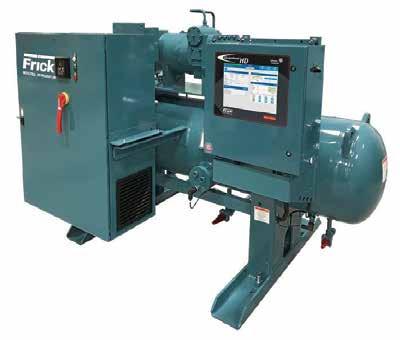
Please visit www.johnsoncontrols.com/frick for more information.
Compressor Packages | Hygienic Air Handling Units | Controls | Condensers and Evaporators | Packaged Solutions
8. Clarifying paragraph (e) to require consideration of natural disasters and extreme temperatures in their PSM programs, in response to E.O. 13990.
9. Expanding paragraph (j) to cover the mechanical integrity of any critical equipment.

10. Clarifying paragraph (j) to better explain “equipment deficiencies”.
11. Clarifying that paragraph (l) covers organizational changes.
12. Amending paragraph (m) to require root cause analysis.
13. Revising paragraph (n) to require coordination of emergency planning with local emergency-response authorities.
14. Amending paragraph (o) to require third-party compliance audits.
15. Including requirements for employers to develop a system for periodic review of, and necessary revisions to their PSM management systems (previously referred to as “Evaluation and Corrective Action”).
16. Requiring the development of written procedures for all elements specified in the standard, and to identify records required by the standard along with a records retention policy (previously referred to as “Written PSM Management Systems”).
In addition to revising requirements of the current PSM standard, OSHA is also considering potential changes to increase the scope of the regulation. Since ammonia refrigeration is already covered by the PSM standard, it is expected that changes to the scope are less likely to impact IIAR members. The potential changes to the scope of the current PSM standard that OSHA is considering include:
1. Clarifying the exemption for atmospheric storage tanks.
2. Expanding the scope to include oiland gas-well drilling and servicing.
3. Resuming enforcement for oil and gas production facilities.
4. Expanding PSM coverage and requirements for reactive chemical hazards.
5. Updating and expanding the list of highly hazardous chemicals in Appendix A.
6. Amending paragraph (k) of the Explosives and Blasting Agents Standard (§ 1910.109) to extend PSM requirements to cover dismantling and disposal of explosives and pyrotechnics.
7. Clarifying the scope of the retail facilities exemption.
8. Defining the limits of a PSMcovered process.
The next step for OSHA will be to develop a proposed rule detailing specific regulatory language changes. The OSHA rulemaking process is generally quite lengthy and takes longer than other agencies such as EPA. As a result, it is very likely that EPA will complete its RMP revisions long before OSHA issues a final rule-changing PSM. Therefore, it is important to closely track EPA’s process which will likely give hints about the ultimate policy directions that OSHA will take. IIAR is actively engaged with both EPA and OSHA on the respective rulemakings and will continue to express concerns and share recommendations to promote and protect the interests of the ammonia refrigeration industry.
Buy low. Sell high.” While this age-old investment advice may seem simple, it can be extremely precarious due to its emphasis on market timing. During a bull market, investors following this advice may be reluctant to invest and too eager to sell. During a bear market, investors may be
reactions. You may even be tempted to try and time the market to minimize your losses or manufacture gains. History tells us succumbing to this temptation would be a mistake. According to Stifel’s Investment Strategy team, a $100 investment in the S&P 500 on May 31, 2002, would have been worth about $510 on June 30, 2022. However, if you
requires you to invest a specific dollar amount on a regular basis. The price of the desired holdings will determine how many shares you are able to buy. This disciplined approach to investing will discourage emotional decisions, dissuade attempts to time the market, and help you continue to confidently pursue your financial goals.
reluctant to sell and too eager to buy. Other investors waiting for the right to time to act may simply stay on the sidelines while missing out on valuable opportunities. No matter how you look at it, timing the market is not an effective strategy for most long-term investors.
During market volatility, you may feel nervous about your finances. This nervousness can lead to knee-jerk
missed the S&P 500’s 30 best trading days during this timeframe, your return would be close to 0%.
A dollar-cost averaging strategy can help you avoid costly mistakes during periods of market volatility. Dollar-cost averaging is a systematic and disciplined investment strategy that is designed to reduce the impact of market fluctuations. This strategy
History has consistently proven that time in the market is more important than timing the market. Creating and maintaining a comprehensive financial plan can help you maintain focus on your long-term goals while ignoring the static caused by daily market fluctuations. Though it may not always seem like it, investing in the stock market has historically proven to be an effective way to pursue your financial goals.
The IIAR and ARF reserve investment funds are currently managed by Stifel Financial Services under the investment policy established by their respective board of directors. Members of IIAR may use the services of Stifel for personal and business investments and take advantage of the reduced rate structure offered with IIAR membership. For additional wealth planning assistance, contact your Stifel representative: Jeff Howard or Jim Lenaghan at (251) 340-5044.
Stifel does not provide legal or tax advice. You should consult with your legal and tax advisors regarding your particular situation.

Past performance is no guarantee of future results. Indices are unmanaged, do not reflect fees or expenses, and you cannot invest directly in an index. The Standard & Poor’s 500 index is a capitalization-weighted index that is generally considered representative of the U.S. large capitalization market. Dollar-cost averaging does not assure a profit or protect against a loss. Investors should consider their ability to continue investing during periods of falling prices.
These materials are provided for general information and educational purposes based upon publicly available information from sources believed to be reliable — we cannot assure the accuracy or completeness of these materials. The information in these materials may change at any time and without notice.

Dollar-cost averaging is a systematic and disciplined investment strategy that is designed to reduce the impact of market fluctuations.
ometimes it may be difficult to understand but we all have free agency to believe what we want. Some people believe the earth is flat. Some believe we never landed on the moon. I suppose there are people who believe those amazing photos from various robotic machines on Mars are fake too.
The list goes on and on. One thing that some people don’t believe is happening is climate change. From my personal experience, I think climate change has and is happening.
it passed over our heads. Hands waving and faces pressed against the copter windows were our kids!
The pilot had asked the kids if they wanted a ride since he wasn’t doing anything at the time. What would you say? “Let’s go!” the kids replied and away they went for a short ride. Things like that don’t happen often, and likely not anymore.
Has the climate changed? At least from my perspective in looking over the last 60 years, yes it has. There are many more wildfires, there are many
so there was minimal refrigeration load. Due to the light load and the low relative humidity in the area, the operator was able to set his head pressure control to 120 psig (a little less than 73°F). All seemed to be working fine until he came in the next day and reviewed the historical data of the operation of the cold rooms still running.
The data showed that the room in the complex furthest from the machine room was not holding temperature and that the mechanical float switch controlling the liquid feed into the surge drum for that room was always calling for liquid feed.
Decades ago, while doing multi-day hikes or canoe trips with my family, we seldom heard of wildfires, at least nowhere near as many as we hear about or experience today. I do recall while we were doing a canoe trip down part of the Yukon River in the Yukon Territory we did experience the effects of a couple of wildfires.
One morning, we woke up and there was ash all over everything. Not too deep, but very noticeable.
Another time we pulled off the Yukon River to visit an ancient Indian village which was a designated historical site. This site was many miles from anything except wilderness, but since it was a designated historical site, men were there to prevent a fire from overrunning and potentially destroying the site. My wife and I walked through the site taking pictures while our kids went exploring. It was only a short time later before the helicopter that we had seen at the site took off and we looked up as
more days when the temperature goes from “not too bad” to “hotter than …”, well you get the idea. Now during the summer multi-day hikes can be stopped due to wildfires closing trails. Things like this rarely happened a few decades ago.
The winters have changed too. I remember when we could get over 4 feet or more of snow. Now 6” to 10” is a lot, but this is very location dependent since the wind patterns seem to have gotten much more chaotic as the polar caps have sunk.
How does climate change relate to a lesson learned in refrigeration? Well, something happened this summer at a large ammonia cold storage facility that was very unusual, in fact, it had never happened before. It was caused by a lower-than-normal refrigeration load, and a now more normal, very hot day. Here is what happened:
Ambient daytime temperatures were around 105°F. This particular facility was nearly empty of last year’s products,
The operator checked the liquid level in the high-pressure receiver (HPR), and it was more than enough to feed many rooms.
He then went up to the surge drum, which was located in a doghouse (penthouse, whatever you want to call it) above the building roof. At the surge drum, he could hear what sounded like vapor going through the make-up liquid solenoid. How could that be? There was a good solid supply of liquid leaving the HPR.
The distance to the surge drum from the HPR was over 600 feet, and the line size to this particular building was 2”, which was large enough to feed all the cold rooms in this particular complex when they were refrigerating, but now there was only one room cooling.
On further study of the historical data, the operator also noticed that during the night the room came back down to temperature and the operation of the liquid float was normal. It cycled ON and OFF as expected.
Here’s the theory of what we think was happening. Due to the reduced

How does climate change relate to a lesson learned in refrigeration?
Well, something happened this summer at a large ammonia cold storage facility that was very unusual, in fact, it had never happened before.
refrigeration load, there was little call for liquid through the 2” line and so the liquid in the line was moving very slowly, much slower than ever before. Since the ambient temperature was hot and the ammonia in the line was about 72°F it was vaporizing and producing the gas that the operator heard going through the liquid solenoid valve.
The operator was able to get the room cooling during the day by raising the head pressure to 140 psig (about 81°F), which seemed to reduce the amount of liquid being vaporized enough so there was sufficient liquid ammonia getting to the surge drum for the actual room refrigeration load.
Another climate change impact has been noticed on some evaporator condenser operations, particularly on condenser operations located close to large bodies of water.

One very large processing and freezing facility located very near the ocean had been having more and more days of higher than normal operating head pressure. The condensers had been designed for the 1% wet bulb temperature taken from the most recent ASHRAE data. The condensers were well maintained and because this system
operated in a vacuum there was a purger in operation.
After checking a number of factors: condenser coil condition, fan, and pump operation spray nozzle operation, purge solenoid operation, condenser circuit inlet, and outlet hand valve positions the refrigeration operators were still scratching their heads about what was going on. Then the ambient conditions were checked. As with a lot of locations, the temperature was higher than normal (I don’t think normal means what it used to anymore), the wet bulb was also higher than the 1% design wet bulb. Higher temperatures meant more ocean water was evaporated, which was apparently rising the local wet bulb and humidity which reduced the evaporative condenser capacity.
How do you design for a changing climate? That is something we are all trying to figure out. Following are a few suggestions to consider:
When looking at environmental data for a specific area, find the most current possible. Data that is even ten years old can be misleading.

Consider the future trend, which in many areas is hotter, and/or wetter, and/or colder. Climate patterns are
more erratic as the total atmospheric movement of the planet changes due to increased temperatures, melting ice caps, and more moisture in the atmosphere. In designing for the future consider these temperatures and wet bulb trends and how they can impact the refrigeration loads and what equipment and materials to use while considering what can be economically justified.

Consider routing of piping and possibly using additional or different insulation, or different reflective surface coverings on piping.
Stay active in industry organizations such as IIAR and RETA where you can learn, access current information, current developments, recent design improvements, and many other areas and issues that can help make much more informed decisions when constructing and operating systems.
Use care when referring to older design guidelines, books, and articles. Many of these may be interesting from a historical perspective but were not written for a world experiencing climate change.
Climate change will affect how we design, construct and operate refrigeration systems.

The goal of operators, contractors, and design engineers is to operate a closed loop refrigeration system as close to design intent as possible. The owner wants maximum value from the equipment and personnel employed at the facility. The presence of gases that do not liquify within the operating conditions add cost to the running of the system.
“Purging” is the process of removing unwanted gases from a refrigeration system. Purging can be performed manually or can be accomplished using specialized equipment that concentrates the non-condensable gases and eliminates them from the system as needed.
The company purchased and properly installed two identical multi-point autopurgers at two separate facilities in the same community. The facilities provide batch precooling services and short term storage of cooled products in 32°F cold rooms. Both purgers functioned well at first, but soon both units suffered random liquid ammonia discharge through the bubbler, which resulted in facility evacuation and
system shut-down. All components checked out “good,” and it was presumed that purge discharge solenoid valves were hanging open when they should not. The vendor was called in to check the installation and provide technical support. Everything was in good order. The suspect solenoid valves were replaced but the random releases continued, albeit sporadically. The company cursed the purger and abandoned it in place, vowing to never buy that brand again.1
The company has been using autopurgers from this manufacturer since the mid-
1980s. The purgers would be moved from location to location to remove noncondensable gases (“air” for the remainder of the paper) from high-side equipment installed on a seasonal basis in the Southwest United States. Prior to the purchase of the first autopurgers, purging was conducted manually.
1 As this paper explains, the problem can happen to any brand of purger. Head pressure was a challenge due to scale accumulating on equipment insulating the heat transfer surface. Not only was heat transfer impaired by a thick scale jacket, the velocity of the air passing the coil tubes increased. Faster air speed meant less residency time of air/ water interfacing the coil surface, which was confirmed through observation that
two-thirds of the coil tube was “dry” in appearance. The dry area developed a “beard” of scale stubble from the 4 o’clock position down and around to the 8 o’clock position of each horizontal pass of the coil. With fans operating at full speed, two-thirds of each tube pass operated “dry” because of the speed of the fan air transiting from below. Consequently, one-third of the heat transfer surface did not receive adequate contact with the air/ water that should have enveloped the entire tube. The water treatment effort was not sufficient: regulations forced a change of treatment material to polymers and the water conservation effort thwarted blow down. It was an ugly period of trial and error. All these issues resulted in higher condensing pressure.
The problem compounded as weeks went by. The scale beard became thicker and the distance between tubes decreased. The speed of the air passing through the coil bundle increased, while the tubes ran “dryer” and the head pressure ran higher.
There were times when it appeared there was 25 psi or more of excess pressure due to non-condensable gases. Manual purging was the only approach at that time.
In those days the Refrigerating Engineers and Technicians Association (RETA) published Industrial Refrigeration Course 1 (IR-1), with the last chapter instructing about purging. Measuring drain leg liquid temperature and pressure from the condenser outlet and comparing the two values with the saturation table for the refrigerant indicates if the fluid is solely refrigerant or a mix of refrigerant and air.The publication explained how to purge while operating. The guidance was to purge where the gas and liquid flow would be the least. This is at the
condenser outlet and from the top of the high pressure receiver where gas should be slowest and coolest.
In the mid-1980s, operators assigned to purging duty were drilled on RETA’s IR-1, which states that discharge from a manual purge process can lose 100 times more ammonia than a refrigerated purger. Operators would often comment that the odor coming from the water in the pails and barrels that were “blown down” into was quite ripe indeed. It was during those purging assignments that I observed strange behavior. There were times that the discharge from the ¼” purge hose (the typical red air hose available from the
condenser coil and “bottling up” in the circuits. In those days it was common practice for a condenser manufacturer to design coil circuits with 4” inlet connections and a 2” outlet connection (Figure 2). The outlet connection was installed flush with the bottom of the drain header to assure full drainage as liquid reached the end of the coil circuits. There was a bent 1/2” schedule 80 nipple to purge from. The nipple was welded to the top of the condenser drain header to direct refrigerant and non-condensables (foul gases) to the purge line for expulsion. This was the case for the condensers I purged in the 1980s. The build-up of scale on the
NAPA store back then) would deliver a robust stream of air bubbles to the bucket. At times, the flow through the hose would change and it began to kick and squirm. Frost formed on the hose. The sound of the flow into the bucket would change to a raspy growl and the hose was at risk of being ejected from the top of the bucket by the recoil at the discharge.
As a result, flow through the purge valve had to be throttled back until the violent behavior subsided. Before long, the frost would melt away and air bubbles were seen in the bucket water.
After several of these experiences, I came to realize that the liquid ejection would happen when the refrigeration load decreased. It appeared to me that the liquid was gathering in the
coils caused extended reaction times to changes in conditions; very sluggish responses to load changes masked the causes of the discharge pressure issues. We were taught that the condition of the refrigerant is always saturated at the discharge of the condenser. I do not agree with that “absolute statement,” and find at times that the refrigerant can appear to be subcooled as it drains out.
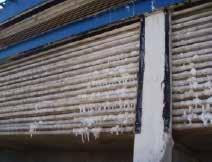
The RETA student guides and equipment operating manuals are written from the viewpoint that the system is operating at a “steady state.” Systems used for process cooling (blast freezing, precooling, water chilling, anything that is a “batch process”) do not enjoy steady state conditions.

When the load is minimal, the discharge pressure will come down because there is not as much refrigerant being shoved into the condenser minute-by-minute as there is when the process load kicks in. A plant may be operating at 25% capacity and then the load quickly increases to 100%. The flow rate of refrigerant may quadruple into the condenser(s) in minutes. The system condensing pressure increases as does the temperature of the condensate, but the system responds to sudden changes at different rates: the pressure rises sooner than the corresponding condensate temperature. The RETA IR-1 now states that the system needs to be running in a steady-state configuration for at least half an hour before taking pressure/temperature readings to evaluate for air. I have observed a system appear to suffer 25 psi excess pressure and the same system appear to have 3 psi excess pressure due to non-condensables. The only difference was when I took the measurements and how “hard” the system was working at the time of measuring.

So, which do you believe? That is the beauty of having an autopurger on the system because it can sort things out. The autopurger condenses a sample of foul gas and concentrates the gas at discharge pressure in a chamber, ready to discharge into an active ammoniaabsorbing “bubbler” and sends the effluent down the sanitary sewer system where it will do no harm. The discharge from the purger is to be a benign flow into the wastewater system. However, other things happen now and again that are highly problematic.
It had been many months since the owners gave up on their investment in two autopurgers at the facilities. The time finally came when proper attention could be given to the problem. After reviewing the paraphernalia available from the autopurger manufacturer, it was concluded that everything was correctly installed and the automation working properly. Yet, liquid would occasionally discharge through the bubbler causing it to violently jerk
Figure 3. The “north” condenser (EC1) at the facility. The “south” condenser is off-frame to the left and is installed in a mirror fashion to EC1.
effluent coming down the line to it.
The facility where the cause of the trouble was discovered has two equally sized condensers which receive proper water treatment and care. There is no scale on the surfaces. The two condensers discharge into their own horizontal collection header, downstream of the P-traps of each coil (Figure 3). Each of the four condenser coils has a solenoid-controlled purge point. Again, the installation was built as designed by a competent and reputable contractor. The discharge from each 6” horizontal collecting drain header dropped through the ceiling into the engine room. The flow from the two condensers comes together and enters the side of a thermosiphon pilot receiver for the oil cooling system of the four compressors. The condenser fans and pumps work
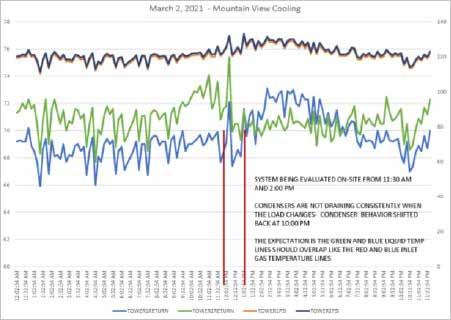
Figure 4. Condenser Drain Temperature Reversal. The green and blue lines are condenser drain leg temperatures. Readings are taken every 10 minutes. The top two lines are outlet drain leg gas pressure. Note that the green and blue lines swap temperatures in the early afternoon and then shift back at about 7:00 pm. It was during one of these reversals that the possibility of flooding back down the foul gas line became evident.
and twitch. The flow of liquid into the diluting water stream causes an intense response that is absorbed physically by the purger’s bubbler system, and the sanitary sewer system has to handle the
in tandem. Pumps come on together first, then fans start as required for floating head pressure. The condensers essentially split the load equally. The
typical head pressure is 135 psig at light load and 150 psig at full load.
While checking for non-condensable gases, something was found to be amiss at the 4” condensate drain lines (Figure 4). The temperature of the liquid
Then came the Ah-ha! moment. Review of the purger’s plumbing schematic (Figure 5) shows that the foul gas comes down from the purge point above. There are many references in the operator’s manual and troubleshooting

accumulator that provides protection for the compressor. No harm will come from that.
in the “north” condenser collector header approximated the wet bulb temperature that day. The companion (south) condenser’s drain temperature was as expected and in agreement with saturation. So, one condenser was discharging subcooled liquid while the other was delivering saturated liquid to the thermosiphon pilot-receiver. If everything is being controlled in the same manner, the same outcome should be expected from the condensers.
However, when the fourth compressor (500 hp ~ 30% of the capacity of the system) came online and loaded up, the condenser that previously was running “properly” began to discharge subcooled liquid. At the same time, the companion condenser that was running improperly began to properly discharge saturated liquid.
This was happening at random, leading to a quite perplexing situation.
guidance from the manufacturer that state that liquid might be coming from a purge point or other location causing problems. The factory warned of this possibility, but the plant was installed and controlled as designed. It isn’t reasonable to suspect something going amiss with control or design. The purger is designed with a mechanical float valve that is to take “casual” condensate that forms in the foul gas line and direct that liquid through a metering device into the evaporator portion of the foul gas concentrating evaporator. This is a small, yet very reliable, float valve. It is designed to handle liquid that forms slowly and deliver that liquid to the evaporator side of the purger concentrating evaporator. Excess flow through the valve returns to the compressor suction from the evaporator chamber, most likely through some sort of suction
Upon closer examination of the plumbing diagram, it can be seen that the liquid gathering in the “dome” of the foul gas concentrator section (the section with the ball float in it) raises the ball, operating a magnet to an attractor, and closing a switch that sends an input to the controller of the purger. The signal instructs the purger to cease discharging air and return to concentrating foul gas into liquid. Under normal conditions, this float switch assembly works just fine as the change of apparent liquid level in the concentrator chamber happens very slowly. However, what if the purger control indicates it is time to discharge air to the bubbler (the float ball has dropped to the “call” position), and the purge point being drawn from suddenly becomes flooded? This would lead to a ¾” schedule 80 pipe that may be fifty to sixty feet in length starting thirty feet above the purger flowing liquid ammonia through it to the tiny float valve that is supposed to handle occasional “casual” liquid formation. Fifty feet of ¾” pipe will have 1.14 gallons of tepid high pressure liquid in it.There will be upwards of a 115 psi pressure differential between the purge point and the 1 psi metering orifice that is to control the flow of discharge into the bubbler. When the autopurger shifts into “purge” mode, a solenoid valve opens that conducts non- condensable vapor from the concentrator to the bubbler, and sends fresh water to the bubbler. The signal to purge is sustained until the ball of the float switch rises up with the liquid level in the concentrator section.
The flow of liquid being pushed by condenser pressure down this pipe is rapid and extreme. The volume itself will completely fill the concentrator section of the purger with liquid, and very suddenly. The float ball has dropped to indicate purging is required, but the liquid rushing into the float ball chamber will come in so fast that liquid will surround the ball completely, locking it into place. The buoyancy of the ball is not enough to overcome the liquid lock-up above the ball, and the switch cannot transfer from the “call”
to the “satisfied” signal. The purger will release liquid ammonia from the purger continuously until there is enough liquid to allow the ball to float up and transfer the signal from “purge required” to “no purge required.”
The shaking then ends, but truck drivers and site employees may have already been chased out of the restrooms by ammonia vapor backflowing from the facility’s sanitary sewer system.
• There is no “intelligence” to stop the purging when this random event occurs.
• Even minor differences in pressure will cause liquid to hang up and cause a flood- back from paired condensers.
1. Bring the foul gas line from the purge points off the condensers to a small high pressure vessel to serve as a trap to accept the flow of liquid.
pressure relief valves added to the mechanical integrity program. There will be no vessel maintenance with cold/ warm skin temperatures that bring on paint degradation and corrosion, and no liquid transfer operation to add to the system to rid the unwanted overflow.
Option #2 looks appealing at this time. Most likely a programmable logic controller (PLC) will be installed and programmed to take the commands from the purger output board and change the timing of purge-cycle steps to ensure a smooth transition from “concentrate” to “purge” actions.
Don’t curse the purger; it is not at fault. The occasional combination of conditions to bring about random liquid flow into the purger’s bubbler is an example of the “Swiss cheese” method of a risk and hazard analysis. The unhappy event will not occur unless the holes of the Swiss cheese align themselves to allow passage of conditions to set off the undesired situation. The holes in our cheese are:
• System load changes affect the condensers in a way that causes liquid to gather deep enough in a condenser discharge pipe to draft liquid down from a purge point.
• The purge point that is backfilled is active at the time of purging.
• The purger activates the purge function, causing a significant pressure differential to draw refrigerant down from the purge point (which may be liquid laden).
2. Amend the controls to force the continued purge sampling signal from the AP-08 to draw from the top of the high pressure receiver. We have confidence that the receiver will not send liquid to the purger through the foul gas line.
1. Consideration #1 will be difficult to figure out – just how large will this additional vessel have to be to reliably intercept liquid flow from a back-filled purge point? This would be a challenging puzzle to solve. The vessel would need to be large enough to intercept the flowing liquid and it would need to provide a separation capability when the potential pressure drop is 100-plus psi through the vessel.
2. Consideration #2 will be the “easiest” approach to a solution. There is no piping or vessel changes involved, and no additional
Our group will be conducting a Management of Change (MOC) with a risk/reward analysis to decide an approach to solving the problem now that we understand why it sporadically occurs. The first step is to investigate whether or not the foul gas passing solenoid valve #4 in Figure 5 remains open while purge solenoid valves #5 and #6 are energized. My recollection is that the purger is allowed to sample full- time whether releasing noncondensables or not. A simple singlepole, double-throw relay triggered by the signal to solenoid valve #5 may provide the least expensive after-market solution. If we find that it is necessary to continue to supply condenser pressure to the purger’s evaporator during a purge cycle, we will investigate applying a PLC to transfer the gas supply to the purge point on top of the highpressure receiver. A different solution may emerge as the group of facility professionals get together to problemsolve. Simply leaving an untrustworthy $30,000 apparatus offline is not an acceptable solution and illustrates poor stewardship of the refrigeration system.
Hansen Technologies Corporation
AP003h – 2015 operation and maintenance manual
Hansen Technologies Corporation
Techni-Brief March 2005 Volume 4 guide
RETA IR-1 course book – Chapter 10 Western Precooling Systems
Don’t curse the purger; it is not at fault. The occasional combination of conditions to bring about random liquid flow into the purger’s bubbler is an example of the “Swiss cheese” method of a risk and hazard analysis.

